College Algebra 3rd Edition Ratti Solutions Manual
Visit to Download in Full: https://testbankdeal.com/download/college-algebra-3rd-edition-ratti-solutions-manual/
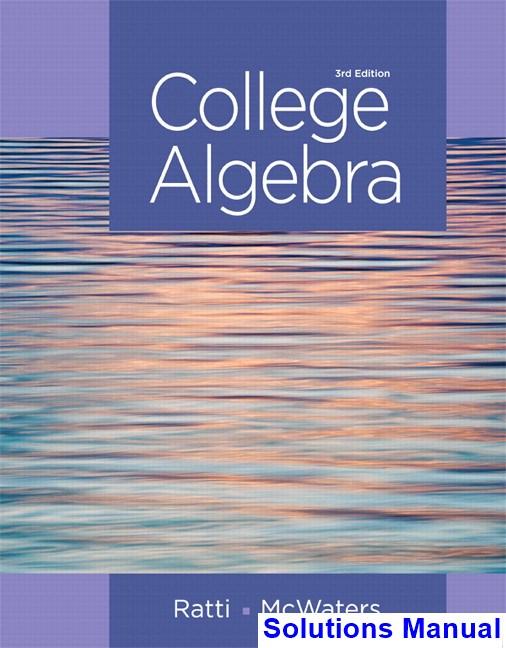

Visit to Download in Full: https://testbankdeal.com/download/college-algebra-3rd-edition-ratti-solutions-manual/

5.
Yes, the triangle is an isosceles triangle.
2. (2005, 17.9), (2006, 17.8), (2007, 17.8), (2008, 17.6), (2009, 17.6), (2010, 16.3), (2011, 16.0), (2012, 18.0)
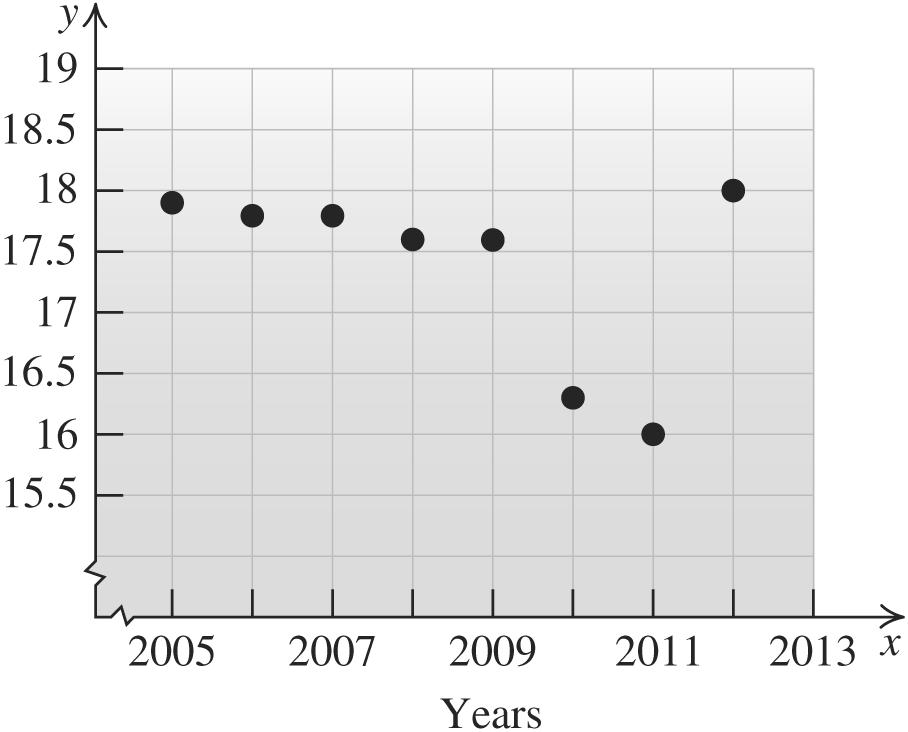
We are asked to find the distance between the points A(60, 0) and B(0, 60).
3. ( ) ( ) ( ) ( ) 1122 ,5,2;,4,1 xyxy=−=−
6.
1. A point with a negative first coordinate and a positive second coordinate lies in the second quadrant.

2. Any point on the x-axis has second coordinate 0
3. The distance between the points ( ) 11 , Pxy and ( ) 22 , Qxy is given by the formula
22 2121 ,.dPQxxyy =−+−
4. ( ) ( ) ( ) ( )
,6,2;,2,0
4. The coordinates of the midpoint M(x, y) of the line segment joining ( ) 11 , Pxy and ( ) 22 , Qxy are given by

5. True
6. False. The point (7, −4) is 4 units to the right and 6 units below the point (3, 2).
7.
(2, 2): Q1; (3, −1): Q4; (−1, 0): x-axis (−2, −5): Q3; (0, 0): origin; (−7, 4): Q2 (0, 3): y-axis; (−4, 2): Q2
8. a. Answers will vary. Sample answer: (2,0), (1,0),(0,0),(1,0),(2,0)
The y-coordinate is 0.
In Exercises 13−22, use the distance formula, ()() 22 2121 dxxyy =−+− and the midpoint formula, (,),1212 22 xxyy xy ++ ⎛ ⎞ = ⎜ ⎟ ⎝ ⎠
13. a. 222 (22)(51)44 d =−+−==
b. () 2215 ,2,3 22 M ++ ⎛⎞ == ⎜⎟
14. a. 222 (23)(55)(5)5 d =−−+−=−=
b. ()3(2)55,0.5,5 22 M +−+ ⎛⎞ == ⎜⎟
b.
The set of all points of the form (x, 1) is a horizontal line that intersects the y-axis at 1.
9. a. If the x -coordinate of a point is 0, the point lies on the y-axis.
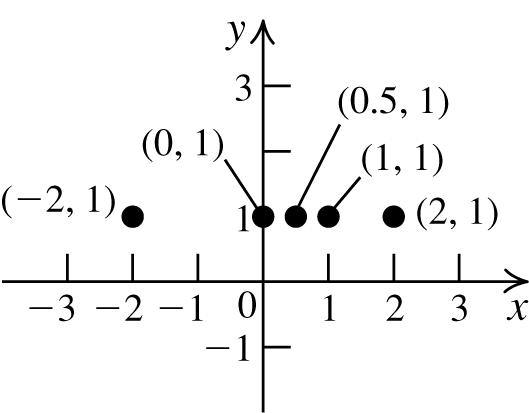
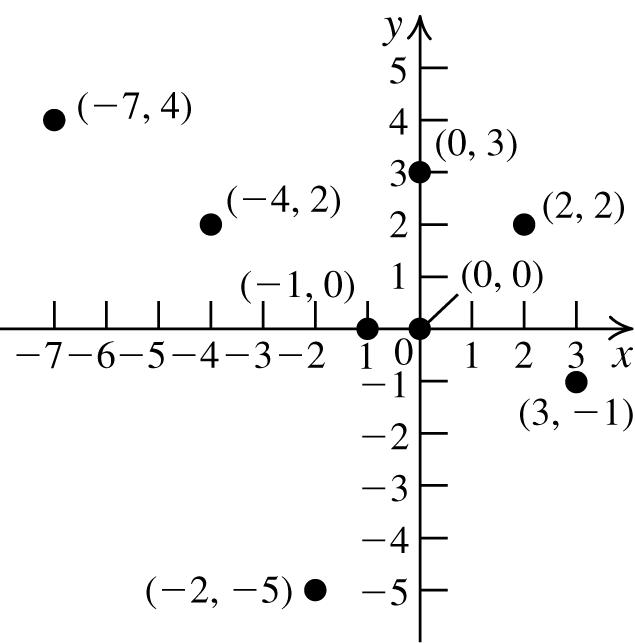
b.
The set of all points of the form (–1, y) is a vertical line that intersects the x-axis at –1.
10. a. A vertical line that intersects the x-axis at –3.
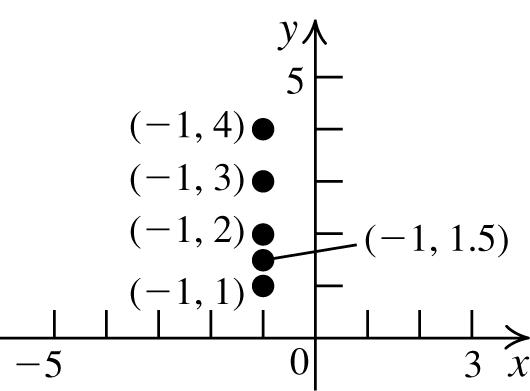
b. A horizontal line that intersects the y -axis at 4.
11. a. 0 y > b. 0 y <
c. 0 x < d. 0 x >
12. a. Quadrant III b. Quadrant I
c. Quadrant IV d. Quadrant II
15. a. 22 22 (2(1))(3(5)) 3213 d =−−+−−−
b. ()125(3),0.5,4 22 M −+−+− ⎛⎞ ==−
16. a. 22 22 (7(4))(91) (3)(10)109 d =−−−+−−
b. () 4(7)1(9),5.5,4 22 M −+−+− ⎛⎞ ==−− ⎜⎟
17. a. 22 22 (3(1))(6.51.5) 4(8)8045 d =−−+−−
b. ()131.5(6.5),1,2.5 22 M −++− ⎛⎞ ==− ⎜⎟
18. a. 22 22
d =−+−− =+−===
(10.5)(10.5) 510 (0.5)(1.5)2.5 22
b. () 0.510.5(1),0.75,0.25 22 M ++− ⎛⎞ ==− ⎜⎟
19. a. () 2 22 22(54)11 d =−+−==
b. () 2245 ,2,4.5 22 M ⎛⎞ ++ == ⎜⎟
20. a. 22 2 (()())() (2)2 dvwvwtt ww
=+−−+− ==
Copyright © 2015 Pearson Education Inc.
b. () ()() 22,, vwvwtt Mvt −+++ ⎛⎞ == ⎜⎟ ⎝⎠
21. a.
22. a.
=−+− =−++−+ =−+=−+ =−=−
()() 22 24222 2()2
dkttk ktkttktk ttkkttkk tktk
22 2222 2222 2
26. It is not possible to arrange the points in such a way so that d(P, Q) + d(Q, R) = d(P, R), so the points are not collinear.
27. P = (–1, 4), Q = (3, 0), R = (11, –8)
b. , 22 tkkt M ++ ⎛⎞ = ⎜⎟
22 2222 22 22 2
=−−+−− =+++++ =++ =++ =+=+
()() 22 242 22 2()2
dnmmn nmnmmmnn mmnn mmnn mnmn
mnnm M mnnm
b. ()() , 22 , 22
+−+− ⎛⎞ = ⎜⎟
23. P = (–1, –2), Q = (0, 0), R = (1, 2)
dPQ dQR dPR
(,)0(1)0(2)5
(,)(10)(20)5
(,)1(1)2(2) 242025
22 22 22 22
=−−+−−= =−+−= =−−+−− =+==
()()
Because d(P, Q) + d(Q, R) = d(P, R), the points are collinear.
24. P = (–3, –4), Q = (0, 0), R = (3, 4)
dPQ dQR dPR =+==
(,)0(3)0(4)255
(,)(30)(40)255
(,)3(3)4(4)
=−−+−−== =−+−== =−−+−−
22 22 22 22
Because d(P, Q) + d(Q, R) = d(P, R), the points are collinear.
25. P = (4, –2), Q = (1, 3), R = (–2, 8)
()() 22 22 (,)143(2)34 (,)(21)(83)34 dPQ dQR =−+−−= =−−+−=
()()
()()
(,)3(1)0442
(,)11(1)84 (12)(12)288122 dPQ dQR dPR =−−+−= =−+−−= =−−+−− =+−==
Because d(P, Q) + d(Q, R) = d(P, R), the points are collinear.
28. It is not possible to arrange the points in such a way so that d(P, Q) + d(Q, R) = d(P, R), so the points are not collinear.
29. It is not possible to arrange the points in such a way so that d(P, Q) + d(Q, R) = d(P, R), so the points are not collinear.
()() ()() 22 22
22
⎝⎠
⎜⎟ ⎝⎠
⎝⎠
Thus, the three points are (−3, 2), (−2, 4), and (−1, 6).
Copyright © 2015 Pearson Education Inc.
32. First, find the midpoint M of PQ ( ) () 412 816 ,4,4 22 M ⎛+−⎞ −+ ==−
Now find the midpoint R of PM. ( ) () 44 84 ,2,0 22 R ⎛+−⎞ −+ ==− ⎜⎟
Finally, find the midpoint S of MQ. ( ) () 412 416 ,10,8 22 S ⎛−+−⎞ + ==− ⎜⎟
Thus, the three points are (−2, 0), (4, −4), and (10, −8).
(,)4(1)1432 22 22 (,)111(1)22 (,)3(1)31 32313231 822
The triangle is an isosceles triangle. 35. ()() dPQ dQR
(,)63625 dPR =−−+−−− =+++−+ == The triangle is equilateral. 40. ()() () ()
=−+−= (,)1.5(0.5)1(1) 5 3 (,)31(1.5)1 2
22 22 22 =−−+−−= =−−−+−− =−++++ == () () () () 22 (,)313(1) 32313231 822
(,)165652 22 2 2
()() =−−−+−− = =−−−+−⎛⎞ ⎜⎟ ⎝⎠ () () () () () () () () () ()
()() 2 2 2 2
22 22 313312.25 3 31 4 32313332.25 1.753 5 31(0.5) (,) 3 (1) 2 31310.25 3 31 4 3231310.25 1.753 5
22 dPR
()() ()() ()() 22 22 22 (,)909(1)145 22 22 22 22
The triangle is scalene. 38. ()() ()() ()() 22 dPQ dQR dRS dSP
(,)4(4)5465
=−+−−−= (,)173(12)17 (,)14(1)11317 (,)221441117 (,)2274(12)17
=−−+−=
22 22 22 ⎛ ⎞ −+−+ ⎝ ⎠ = +−+⎛⎞ ⎜⎟ ⎝⎠ −++−+ = +− = = +−−⎛⎞ ⎜⎟ ⎝⎠ ⎛⎞ −+−+ ⎝⎠ = +++⎛⎞ ⎜⎟ ⎝⎠ =−++−+ ++ = The triangle is equilateral. 41. First find the lengths of the sides: ()() ()() ()() ()()
(,)0(4)24213
The triangle is isosceles.
22 22 =−−+−−= =−−+−= =−+−−= =−+−−−= (continuedonnextpage)
Copyright © 2015 Pearson Education Inc.
53. 16,92914,612 15,770.5 2 M + ==
There were about 15,771 murders in 2009.
54. 2009 is the midpoint of the initial range, so
2009 228320 274 2 M + == .
2008 is the midpoint of the range
[2007, 2009], so 2008 228274 251 2 M + ==
2010 is the midpoint of the range [2009, 2011], so 2010 274320 297 2 M + == .
So, in 2008, $251 billion was spent; in 2009, $274 billion was spent, and $297 was spent in 2010.
55. 2008 is the midpoint of the initial range, so
2008 548925 736.5 2 M + ==
2006 is the midpoint of the range [2004, 2008], so
2006 548736.5 642.25 2 M + ==
2005 is the midpoint of the range [2004, 2006], so
2005 548642.25 595.125 2 M + == .
2007 is the midpoint of the range [2006, 2008], so
2007 642.25736.5 689.375 2 M + ==
Use similar reasoning to find the amounts for 2009, 2010, and 2011. Defense spending was as follows:
Year Amount spent
2004 $548 billion
2005 $595.125 billion
2006 $642.25 billion
2007 $689.375 billion
2008 $736.5 billion
2009 $783.625 billion
2010 $830.75 billion
2011 $877.875 billion
2012 $925 billion
56. Denote the diagonal connecting the endpoints of the edges a and b by d. Then a, b, and d form a right triangle. By the Pythagorean theorem, 222abd += . The edge c and the diagonals d and h also form a right triangle, so 222 cdh += . Substituting 2 d from the first equation, we obtain 2222 abch ++=
Copyright © 2015 Pearson Education Inc.


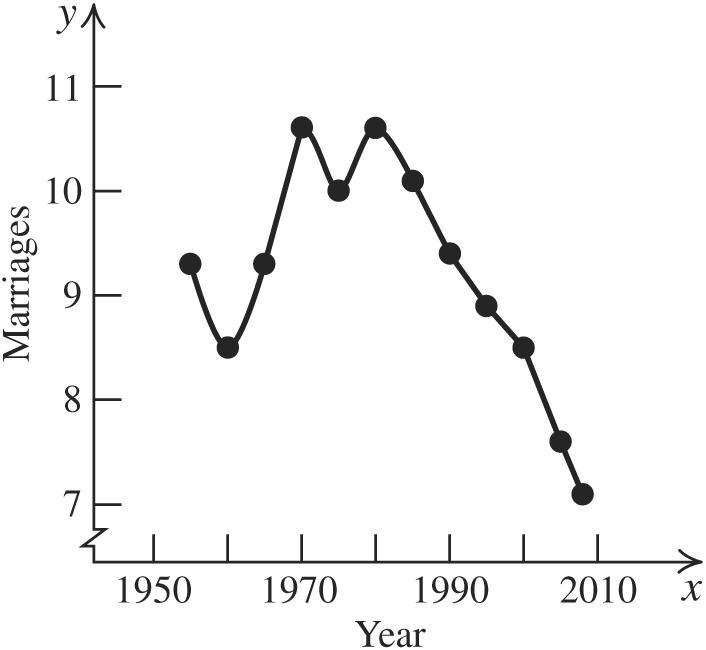
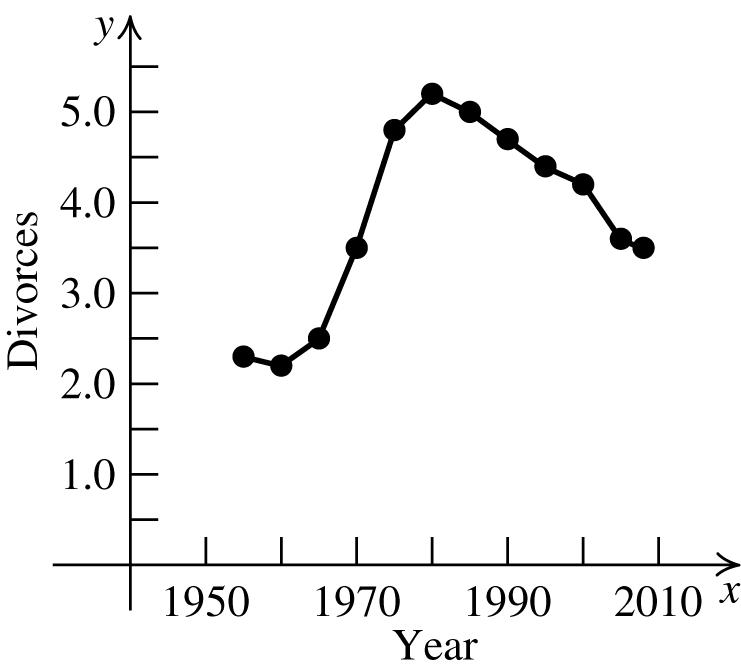

60. a. If AB is one of the diagonals, then DC is the other diagonal, and both diagonals have the same midpoint. The midpoint of AB is
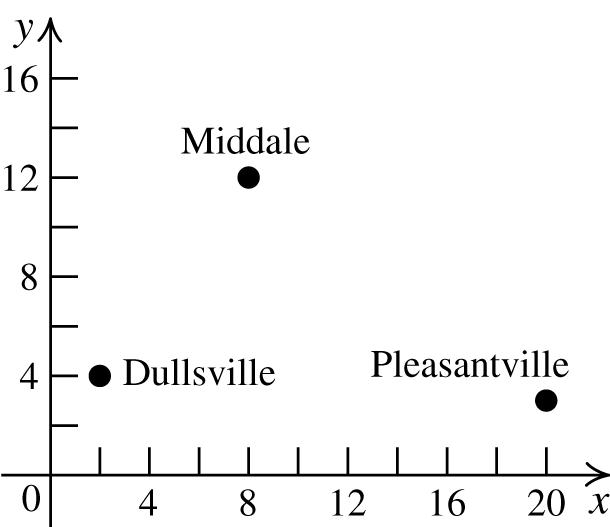
() 2534 ,3.5,3.5 22 ++ ⎛⎞ = ⎜⎟ ⎝⎠ . The midpoint of DC = 38 (3.5,3.5),. 22 xy++ ⎛⎞ =
dDM dMP
(,)(800200)(1200400) 1000
=−+−
b. 22 22
=−+−
(,)(2000800)(3001200) 1500
The distance traveled by the pilot = 1000 + 1500 = 2500 miles.
c. 22 (,)(2000200)(300400)
So we have 3 3.54 2 x x + =⇒= and 8 3.5 2 y + =⇒ 1 y =−
The coordinates of D are (4, –1).
b. If AC is one of the diagonals, then DB is the other diagonal, and both diagonals have the same midpoint. The midpoint of AC is
() 2338 ,2.5,5.5 22 ++ ⎛⎞ =
58. First, find the initial length of the rope using the Pythagorean theorem:
22 241026 c =+=
After t seconds, the length of the rope is 26 – 3t. Now find the distance from the boat to the dock, x, using the Pythagorean theorem again and solving for x: 222
59. The midpoint of the diagonal connecting (0, 0) and (a + b, c) is 22,. abc + ⎛⎞ ⎜⎟ ⎝⎠ The midpoint of the diagonal connecting (a, 0) and (b, c) is also 22,. abc + ⎛⎞ ⎜⎟ ⎝⎠ Because the midpoints of the two diagonals are the same, the diagonals bisect each other.
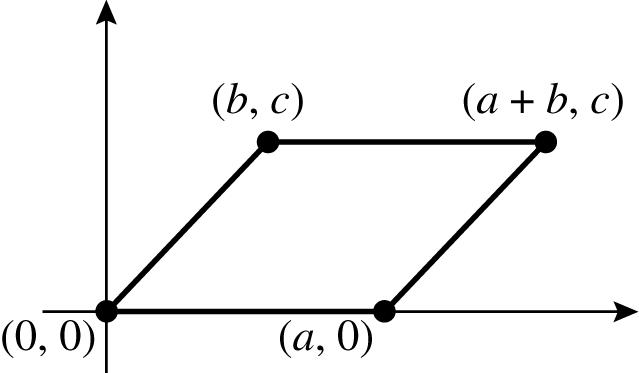
=
. The midpoint of DB = 54 (2.5,5.5),. 22 xy++
So we have 5 2.50 2 x x + =⇒= and 4 5.5 2 y + =⇒ 7 y =
The coordinates of D are (0, 7).
c. If BC is one of the diagonals, then DA is the other diagonal, and both diagonals have the same midpoint. The midpoint of BC is () 5348 ,4,6 22 ++ ⎛⎞ =
. The midpoint of DA is 23 (4,6),. 22 xy++ ⎛ ⎞ = ⎜ ⎟ ⎝ ⎠ So we have 2 46 2 x x + =⇒= and 3 69 2 y y + =⇒=
The coordinates of D are (6, 9).
61. The midpoint of the diagonal connecting (0, 0) and (x, y) is , 22 xy ⎛ ⎞ ⎜ ⎟ ⎝ ⎠ . The midpoint of the diagonal connecting (a, 0) and (b, c) is 22,. abc + ⎛ ⎞ ⎜ ⎟ ⎝ ⎠ Because the diagonals bisect each other, the midpoints coincide. So 22 xab + =⇒ xab =+ , and 22 yc yc=⇒= Therefore, the quadrilateral is a parallelogram.
Copyright © 2015 Pearson Education Inc.
62. a. The midpoint of the diagonal connecting (1, 2) and (5, 8) is () 1528 ,3,5. 22 ++ ⎛⎞ = ⎜⎟ ⎝⎠
The midpoint of the diagonal connecting (–2, 6) and (8, 4) is 2864 22,(3,5). −++ ⎛⎞ = ⎜⎟ ⎝⎠ Because the midpoints are the same, the figure is a parallelogram.
b. The midpoint of the diagonal connecting (3, 2) and (x, y) is 32 22,. xy++ ⎛ ⎞ ⎜ ⎟ ⎝ ⎠ The midpoint of the diagonal connecting (6, 3) and (6, 5) is (6, 4). So 3 69 2 x x + =⇒= and 2 46 2 y y + =⇒=
63. Let P(0, 0), Q(a, 0), R(a + b, c), and S(b, c) be the vertices of the parallelogram. PQ = RS = 22 (0)(00). aa −+−= QR = PS =
() 2 222 ()(0). abacbc +−+−=+
The sum of the squares of the lengths of the sides = 222 2(). abc ++
22
(,)(). dPRabc =++
() 2 2 (,)(0). dQSabc =−+−
The sum of the squares of the lengths of the diagonals is ( ) ( ) ()()2222 abcabc +++−+=
222222 22 aabbcaabbc ++++−++= 222222 2222(). abcabc ++=++
64. Let P(0, 0), Q(a, 0), and R(0,b) be the vertices of the right triangle. The midpoint M of the hypotenuse is 22,. ab ⎛⎞
(,)0 22 222 (,)0022 ab dRMb abab ab dPM abab
=−+−⎛⎞⎛⎞ ⎜⎟⎜⎟ ⎝⎠⎝⎠ + ⎛⎞⎛⎞ =−+= ⎜⎟⎜⎟ ⎝⎠⎝⎠ =−+−⎛⎞⎛⎞ ⎜⎟⎜⎟ ⎝⎠⎝⎠ + ⎛⎞⎛⎞ =−+−= ⎜⎟⎜⎟ ⎝⎠⎝⎠
65. Let P(0, 0), Q(a, 0), and R(0, a) be the vertices of the triangle.
caacaca acc
=+⇒=⇒=⇒ ==
Using the Pythagorean theorem, we have 2222222 12 2 2
66. Since ABC is an equilateral triangle and O is the midpoint of AB, then the coordinates of A are (−a, 0).
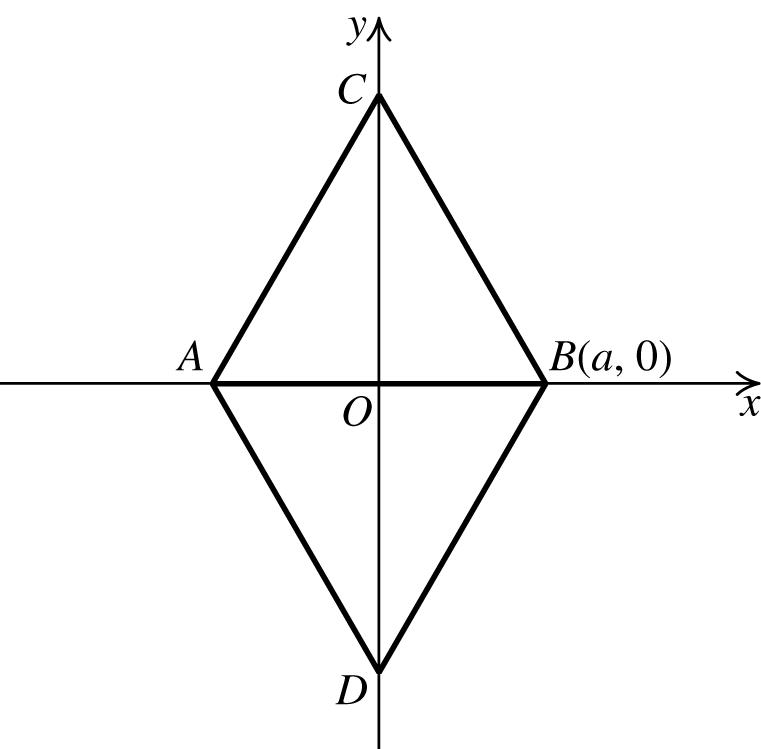
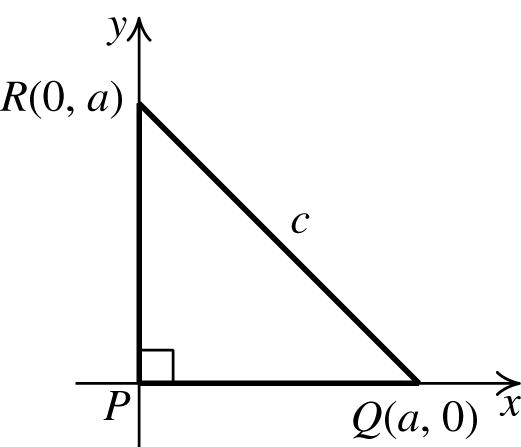
AB = AC = AB = 2a. Using triangle BOC and the Pythagorean theorem, we have ()2 22222 22222 2 433 BCOBOCaaOC aaOCaOCOCa =+⇒=+⇒ =+⇒=⇒= Thus, the coordinates of C are ( ) 0,3a and the coordinates of D are ( ) 0,3. a
Copyright © 2015 Pearson Education Inc.
To show that M is the midpoint of the line segment PQ, we need to show that the distance between M and Q is the same as the distance between M and P and that this distance is half the distance from P to Q
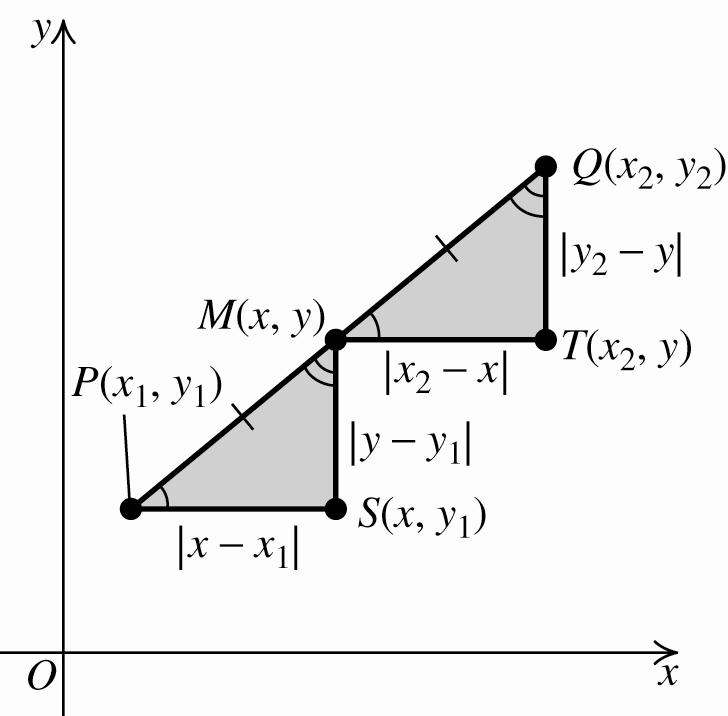
69. a. y-axis
b. x-axis
70. a. The union of the x- and y-axes
b. The plane without the x- and y-axes
71. a. Quadrants I and III
b. Quadrants II and IV
72. a. The origin
b. The plane without the origin
73. a. Right half-plane
b. Upper half-plane
74. Let (x, y) be the point. The point lies in if
Quadrant I x > 0 and y > 0

Quadrant II x < 0 and y > 0
Quadrant III x < 0 and y < 0
Quadrant IV x > 0 and y < 0
1. 2 1 yx=−+
x y = −x 2 + 1 (x, y)
−2 y = (−2)2 + 1 (−2, −3)
−1 y = (−1)2 + 1 (−1, 0)
0 y = (0)2 + 1 (0, 1)
1 y = (1)2 + 1 (1, 0)
2 y = (2)2 + 1 (2, −3)
2. To find the x-intercept, let y = 0, and solve the equation for x: 2 0232 xx =+−⇒
()() 1 0212 or 2 2 xxxx =−+⇒==− . To find the y-intercept, let x = 0, and solve the equation for y:
()() 2 203022.yy =+−⇒=−
The x-intercepts are 1 2 and −2; the y-intercept is −2.
3. To test for symmetry about the y-axis, replace x with –x to determine if (–x, y) satisfies the equation.
() 2 22211xyxy −−=⇒−= , which is the same as the original equation. So the graph is symmetric about the y-axis.
4. x-axis: () 3 223 , xyxy =−⇒=− which is not the same as the original equation, so the equation is not symmetric with respect to the x-axis.
y-axis: () 2 323 , xyxy −=⇒= which is the same as the original equation, so the equation is symmetric with respect to the y-axis. origin: ()()23 23 , xyxy −=−⇒=− which is not the same as the original equation, so the equation is not symmetric with respect to the origin.
a. First, find the intercepts. If t = 0, then y = 324, so the y-intercept is (0, 324). If y = 0, then we have
So, the t-intercepts are (−9, 0) and (9, 0). Next, check for symmetry.
t-axis: 4277324ytt −=−++ is not the same as the original equation, so the equation is not symmetric with respect to the t-axis.
y-axis: ()()4277324ytt =−−+−+⇒
4277324,ytt=−++ which is the same as the original equation. So the graph is symmetric with respect to the y-axis.
origin: ()()4277324ytt −=−−+−+⇒
4277324,ytt −=−++ which is not the same as the original equation. So the graph is not symmetric with respect to the origin. Now, make a table of values. Since the graph is symmetric with respect to the y-axis, if (t, y) is on the graph, then so is (−t, y). However, the graph pertaining to the physical aspects of the problem consists only of those values for t ≥ 0.
t y = −t4 + 77t2 + 324 (t, y)
0 324 (0, 324)
1 400 (1, 400)
2 616 (2, 616)
3 936 (3, 936)
4 1300 (4, 1300)
5 1624 (5, 1624)
6 1800 (6, 1800)
7 1696 (7, 1696)
8 1156 (8, 1156)
9 0 (9, 0)
Copyright © 2015 Pearson Education Inc.
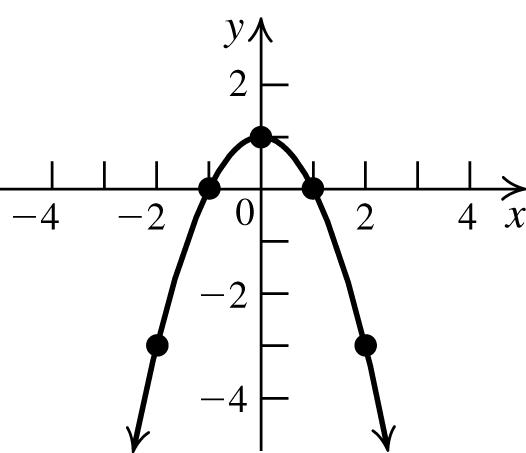
c. The population becomes extinct after 9 years.
6. The standard form of the equation of a circle is ()()222 xhykr −+−= (h, k) = (3, −6) and r = 10 The equation of the circle is 22 (3)(6)100. xy−++=
7. ()()()() 22 2136,2,1,6 xyhkr −++=⇒=−=
This is the equation of a circle with center (2, −1) and radius 6.
1. The graph of an equation in two variables, such as x and y, is the set of all ordered pairs (a, b) that satisfy the equation
2. If (–2, 4) is a point on a graph that is symmetric with respect to the y-axis, then the point (2, 4) is also on the graph.
3. If (0, −5) is a point of a graph, then −5 is a y- intercept of the graph.
4. An equation in standard form of a circle with center (1, 0) and radius 2 is () 2 2 14xy−+= .
5. False. The equation of a circle has both an 2 x -term and a 2 y -term. The given equation does not have a 2 y -term.
6. False. The graph below is an example of a graph that is symmetric about the x-axis, but does not have an x-intercept.
8. 22 46120xyxy++−−=⇒
224612 xxyy++−=
Now complete the square:
2244691249 xxyy+++−+=++⇒
()() 22 2325xy++−=
This is a circle with center (−2, 3) and radius 5.

In exercises 7−14, to determine if a point lies on the graph of the equation, substitute the point’s coordinates into the equation to see if the resulting statement is true.
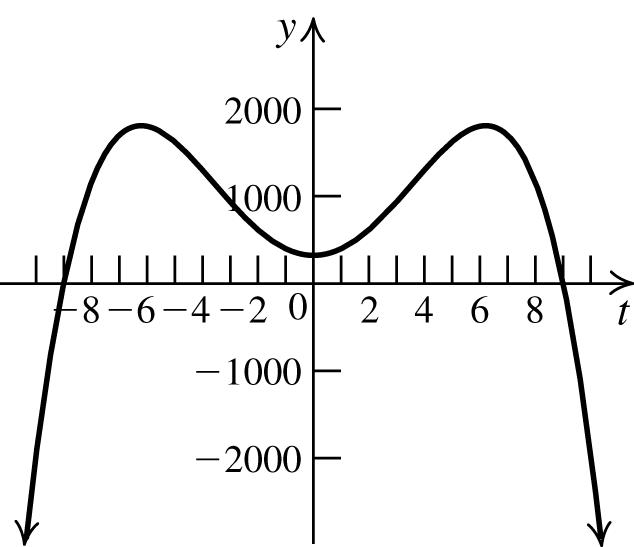
7. on the graph: (–3, –4), (1, 0), (4, 3); not on the graph: (2, 3)
8. on the graph: (–1, 1), (1, 4), 5 ,0 3 ⎛⎞ ⎜⎟ ⎝⎠ ; not on the graph: (0, 2)
9. on the graph: (3, 2), (0, 1), (8, 3); not on the graph: (8, –3)
10. on the graph: (1, 1), 1 2, 2 ⎛⎞ ⎜⎟ ⎝⎠ ; not on the graph: (0, 0), 1 3, 3 ⎛ ⎞ ⎜ ⎟ ⎝ ⎠
11. on the graph: (1, 0), ( ) ( ) 2,3,2,3 ; not on the graph: (0, –1)

12. Each point is on the graph.
13. a. x-intercepts: –3, 3; no y-intercepts
Copyright © 2015 Pearson Education Inc.
b. Symmetric about the x -axis, y -axis, and origin.
14. a. No x-intercepts; y-intercepts: –2, 2
b. Symmetric about the x -axis, y -axis, and origin.
15. a. x-intercepts: −3, 3; y-intercepts: –2, 2
b. Symmetric about the x -axis, y -axis, and origin.
16. a. x-intercepts: −3, 3; y-intercepts: –3, 3
b. Symmetric about the x -axis, y -axis, and origin.
17. a. x-intercept: 0; y-intercept: 0
b. Symmetric about the x -axis.
18. a. x-intercepts: ,0,; ππ y-intercept: 0
b. Symmetric about the origin.
19. a. x-intercepts: −3, 3; y-interceps: 2
b. Symmetric about the y -axis.
20. a. x-intercepts: 33 2222,,,; ππππ y-intercept: 2
b. Symmetric about the y -axis.
21. a. No x-intercept; y -intercept: 1
b. No symmetries
22. a. x-intercept: 1; no y-intercepts
b. No symmetries
23. a. x-intercepts: 0, 3; y-intercept: 0
b. Symmetric about the x -axis.
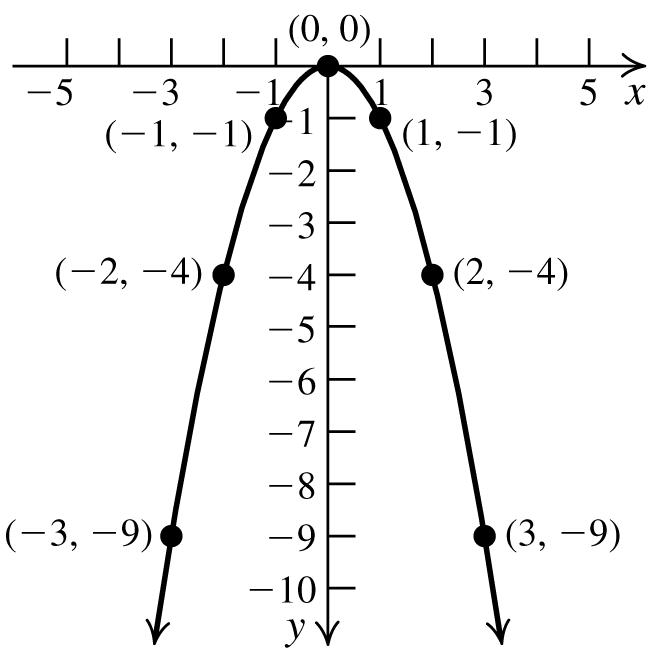
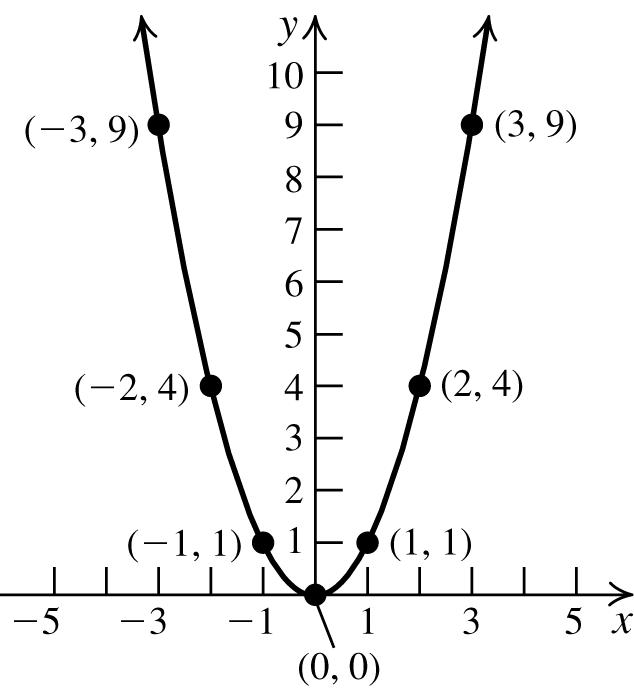
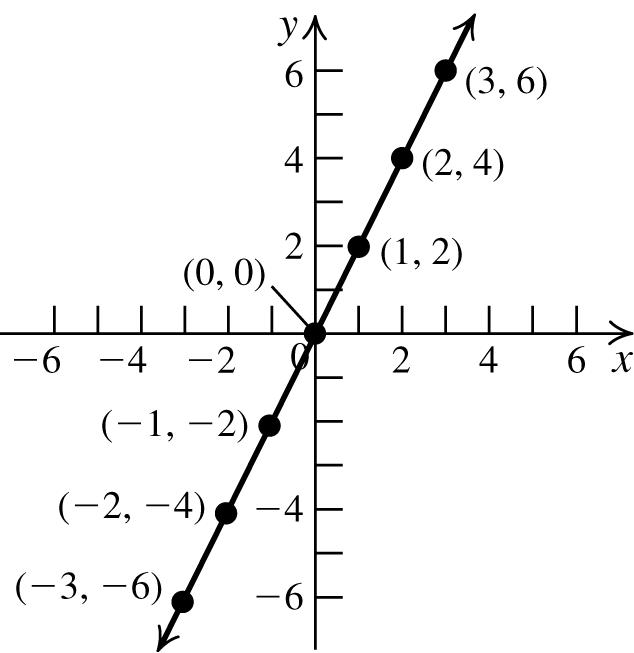
24. a. x-intercept: 0; y-intercept: 0
b. Symmetric about the x -axis, y -axis, and origin.

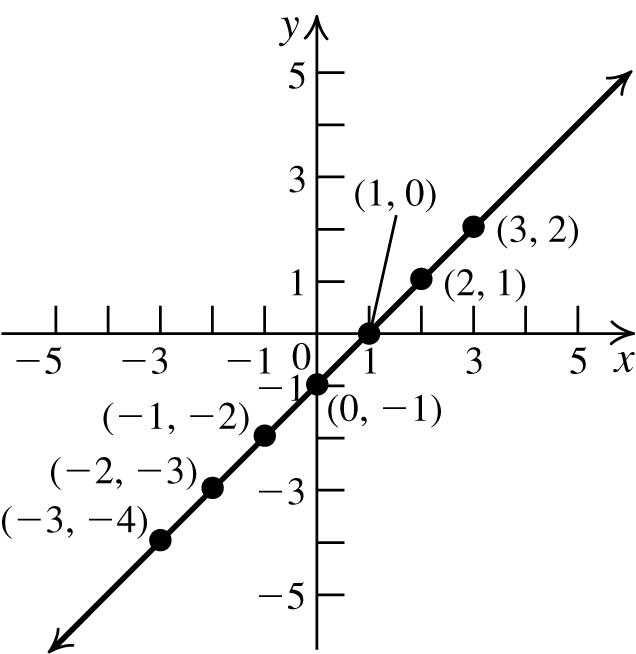
Copyright © 2015 Pearson Education Inc.
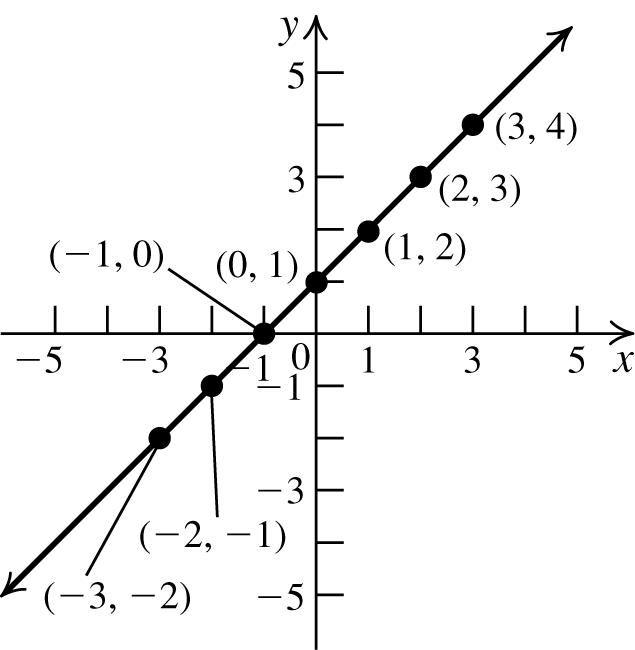


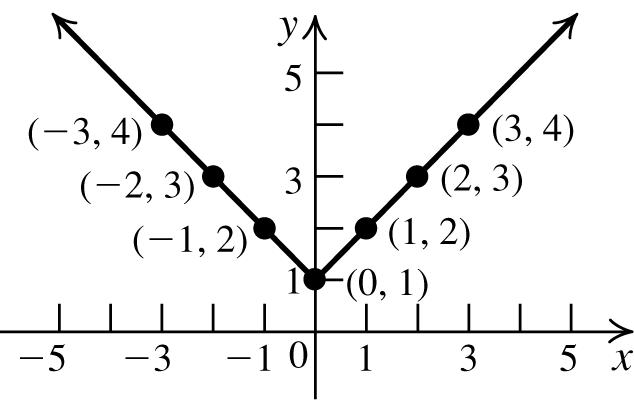
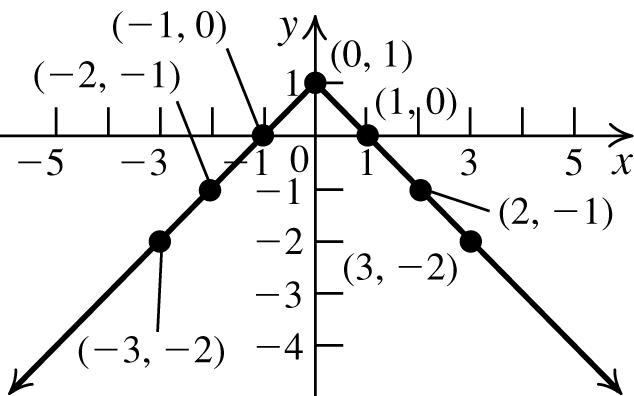
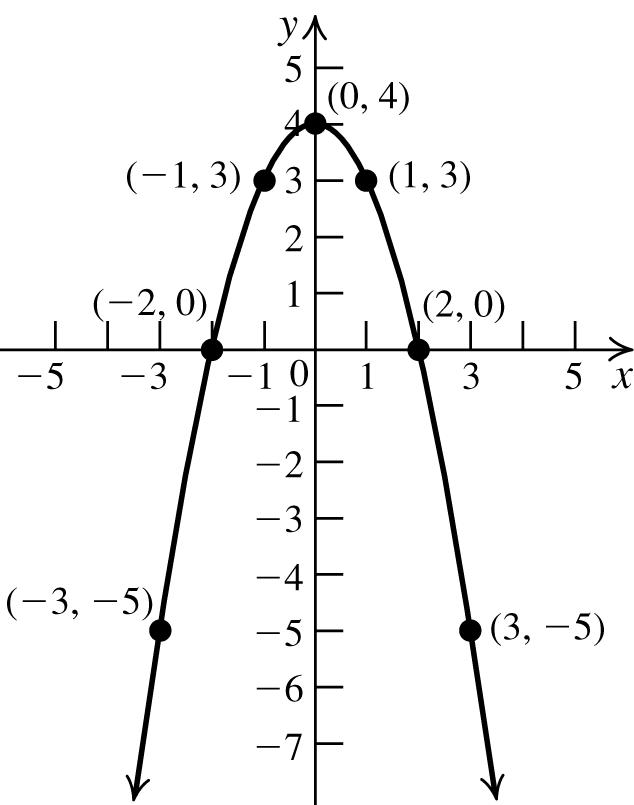


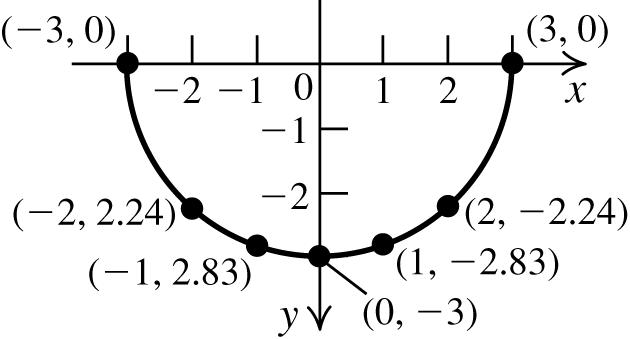

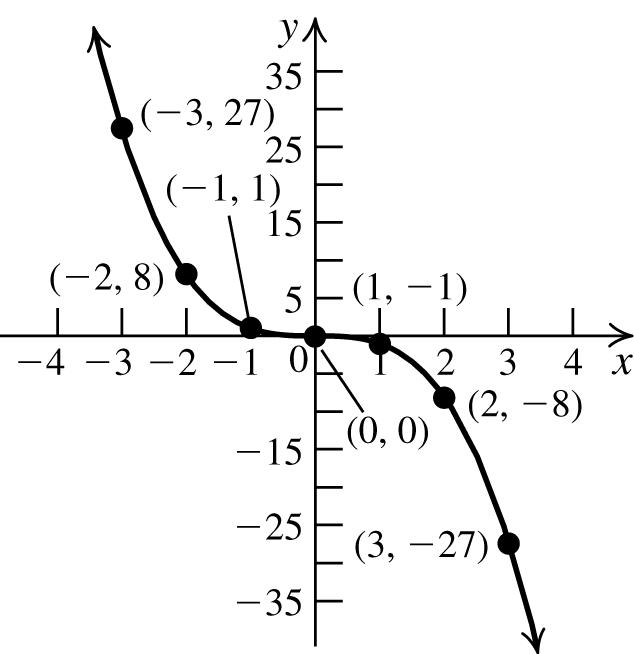

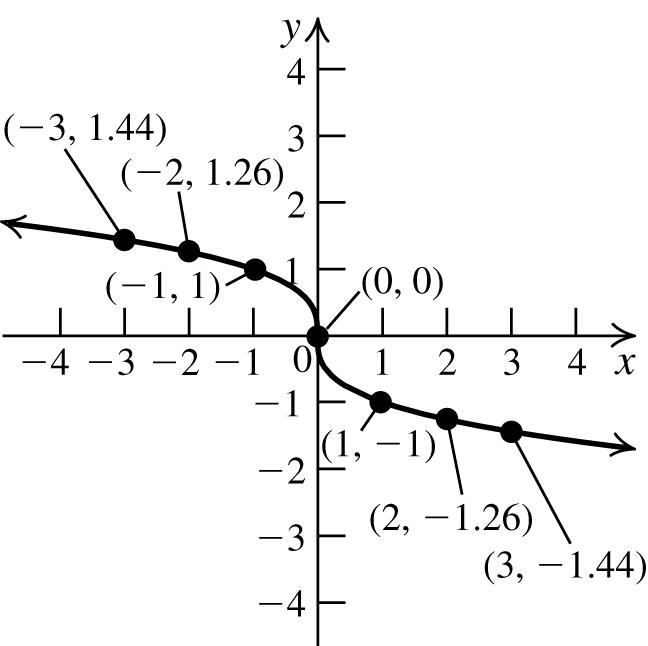
47. To find the x -intercept, let y = 0, and solve the equation for x: 34(0)124. xx +=⇒= To find the y-intercept, let x = 0, and solve the equation for y: 3(0)4123. yy +=⇒=
The x-intercept is 4; the y -intercept is 3.
48. To find the x -intercept, let y = 0, and solve the equation for x: 0 15. 53 x x +=⇒= To find the y-intercept, let x = 0, and solve the equation for y: 0 13. 53 y y +=⇒=
The x-intercept is 5; the y -intercept is 3.
49. To find the x -intercept, let y = 0, and solve the equation for x: 2 0684 or xxx =−+⇒=
2. x = To find the y -intercept, let x = 0, and solve the equation for y: 2 06(0)8 y =−+⇒
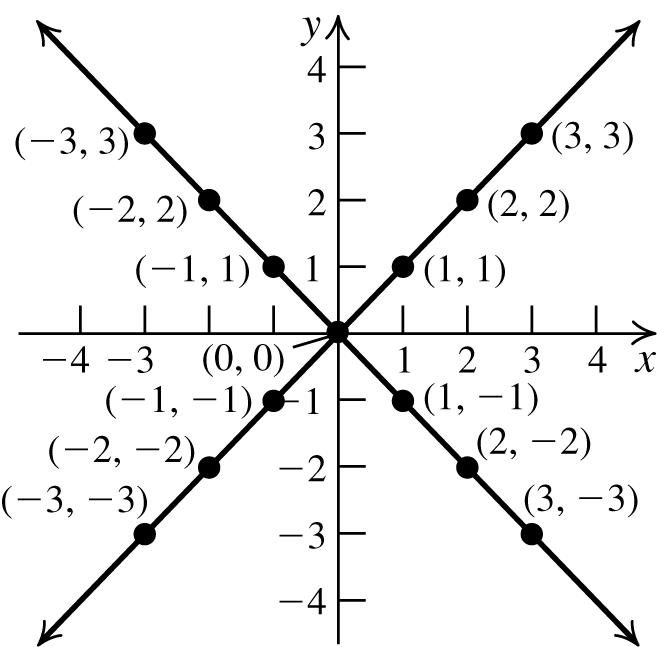
8. y = The x-intercepts are 2 and 4; the y-intercept is 8.
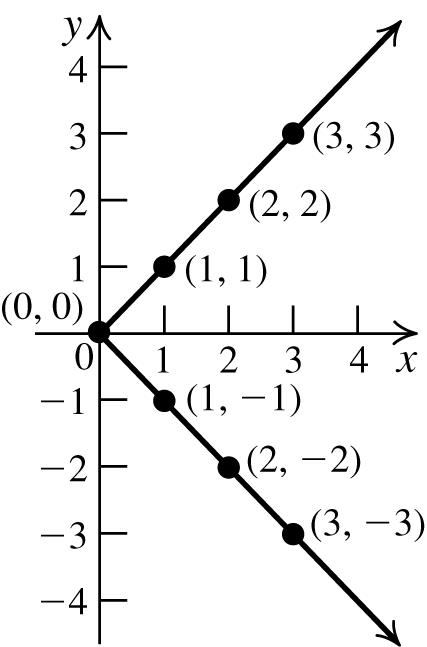
50. To find the x -intercept, let y = 0, and solve the equation for x: 2 05(0)66.xx =−+⇒=
To find the y -intercept, let x = 0, and solve the equation for y: 2 0562 or yyy =−+⇒=
3. y = The x-intercept is 6; the y -intercepts are 2 and 3.
51. To find the x -intercept, let y = 0, and solve the equation for x: 22042. xx+=⇒=±
To find the y -intercept, let x = 0, and solve the equation for y: 22 042. yy +=⇒=±
The x-intercepts are –2 and 2; the y-intercepts are –2 and 2.
52. To find the x -intercept, let y = 0, and solve the equation for x: 2 093. xx =−⇒=±
To find the y -intercept, let x = 0, and solve the equation for y: 2 903.yy=−⇒=
The x-intercepts are –3 and 3; the y-intercept is 3.
53. To find the x -intercept, let y = 0, and solve the equation for x: 2 011. xx =−⇒=±

To find the y -intercept, let x = 0, and solve the equation for y: 2 01 y =−⇒ no solution. The x-intercepts are –1 and 1; there is no y-intercept.
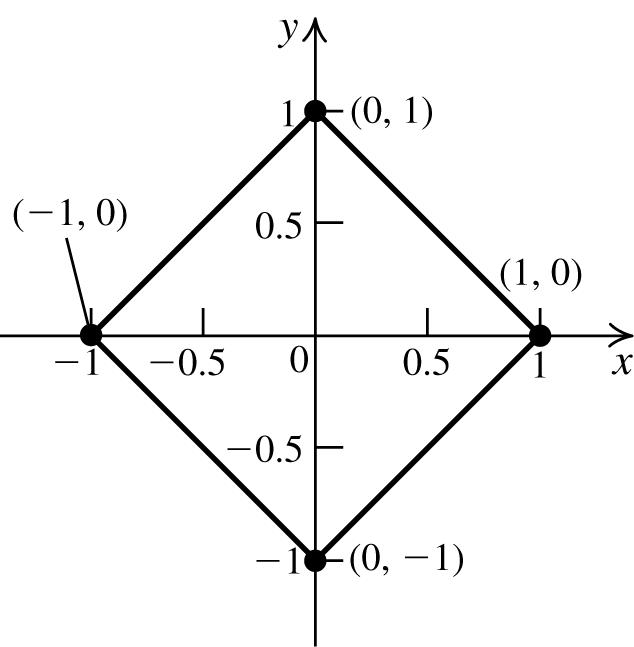
54. To find the x -intercept, let y = 0, and solve the equation for x: (0)1 x =⇒ no solution.
To find the y -intercept, let x = 0, and solve the equation for y: (0)1 y =⇒ no solution. There is no x-intercept; there is no y-intercept.
55. To find the x -intercept, let y = 0, and solve the equation for x: 2 01 xx =++⇒
()() () 2 11411 13 , 212 x −±− −±− == which are not real solutions. Therefore, there are no x-intercepts. To find the y-intercept, let x = 0, and solve the equation for y:
2 0011. y =++=
There are no x-intercepts; the y-intercept is 1.
Copyright © 2015 Pearson Education Inc.
56. To find the x -intercept, let y = 0, and solve the equation for x:
() 333300111. xxxx ++=⇒=⇒= To find the y-intercept, let x = 0, and solve the equation for y:
() 333 030111. yyyy ++=⇒=⇒=
The x-intercept is 1; the y -intercept is 1. In exercises 57–66, to test for symmetry with respect to the x-axis, replace y with –y to determine if (x, –y) satisfies the equation. To test for symmetry with respect to the y-axis, replace x with –x to determine if (–x, y) satisfies the equation. To test for symmetry with respect to the origin, replace x with –x and y with –y to determine if (–x, –y) satisfies the equation.
57. 2 1 yx −=+ is not the same as the original equation, so the equation is not symmetric with respect to the x -axis.
2 ()1yx=−+⇒ 2 1 yx=+ , so the equation is symmetric with respect to the y-axis.
2 ()1yx −=−+⇒ 2 1 yx −=+ , is not the same as the original equation, so the equation is not symmetric with respect to the origin.
58. 22 ()11xyxy =−+⇒=+ , so the equation is symmetric with respect to the x-axis.
2 1 xy −=+ is not the same as the original equation, so the equation is not symmetric with respect to the y -axis.
2 ()1xy −=−+⇒ 2 1 xy −=+ is not the same as the original equation, so the equation is not symmetric with respect to the origin.
59. 3 yxx−=+ is not the same as the original equation, so the equation is not symmetric with respect to the x -axis.
3 () yxx=−−⇒ 3 yxx=−−⇒
3 ()yxx =−+ is not the same as the original equation, so the equation is not symmetric with respect to the y -axis.
33 () yxxyxx −=−−⇒−=−−⇒
33 (), yxxyxx −=−+⇒=+ so the equation is symmetric with respect to the origin.
60. 3 2 yxx−=− is not the same as the original equation, so the equation is not symmetric with respect to the x -axis.
3 2()() yxx=−−−⇒ 3 2 yxx=−+⇒
3 2() yxx =−− is not the same as the original equation, so the equation is not symmetric with respect to the y -axis.
2()()233 yxxyxx −=−−−⇒−=−+⇒
2()233 yxxyxx −=−−⇒=− , so the equation is symmetric with respect to the origin.
61. 5242yxx−=+ is not the same as the original equation, so the equation is not symmetric with respect to the x-axis.
5()2()42yxx =−+−⇒ 5242yxx =+ , so the equation is symmetric with respect to the y-axis.
442 5()2()52 yxxyxx −=−+−⇒−=+ is not the same as the original equation, so the equation is not symmetric with respect to the origin.
62. 32642 yxxx −=−++ is not the same as the original equation, so the equation is not symmetric with respect to the x-axis.
642 3()2()() yxxx =−−+−+−⇒
32642 yxxx =−++ , so the equation is symmetric with respect to the y-axis.
642 3()2()() yxxx −=−−+−+−⇒
32642 yxxx −=−++ is not the same as the original equation, so the equation is not symmetric with respect to the origin.
63. 3253yxx−=−+ is not the same as the original equation, so the equation is not symmetric with respect to the x-axis.
53 3()2() yxx =−−+−⇒ 3253yxx =− is not the same as the original equation, so the equation is not symmetric with respect to the y-axis.
5353 3()2()32 yxxyxx −=−−+−⇒−=−⇒
5353 (32)32 yxxyxx −=−−+⇒=−+ , so the equation is symmetric with respect to the origin.
Copyright © 2015 Pearson Education Inc.
64. 2 2 yxx−=− is not the same as the original equation, so the equation is not symmetric with respect to the x -axis.
2 2() yxx=−−−⇒ 2 2 yxx =− , so the equation is symmetric with respect to the y-axis.
2 2() yxx −=−−−⇒ 2 2 yxx−=− is not the same as the original equation, so the equation is not symmetric with respect to the origin.
65. 2222 ()2()121 xyxyxyxy −+−=⇒−= is not the same as the original equation, so the equation is not symmetric with respect to the x-axis.
2222 ()2()121 xyxyxyxy −+−=⇒−= is not the same as the original equation, so the equation is not symmetric with respect to the y-axis.
22 ()()2()()1 xyxy −−+−−=⇒
22 21xyxy+= , so the equation is symmetric with respect to the origin.
66. 2222()1616 xyxy+−=⇒+= , so the equation is symmetric with respect to the x-axis.
2222 ()1616 xyxy −+=⇒+= , so the equation is symmetric with respect to the y-axis.
2222 ()()1616 xyxy −+−=⇒+= , so the equation is symmetric with respect to the origin.
For exercises 67–80, use the standard form of the equation of a circle, ()()222 xhykr −+−= .
67. Center (2, 3); radius = 6
68. Center (–1, 3); radius = 4
69. Center (–2, –3); radius = 11
70. Center 13 , 22 ⎛⎞ ⎜⎟ ⎝⎠ ; radius = 3 2
71. 22(1)4xy+−=
72. 22 (1)1 xy−+=
73. 22 (1)(2)2 xy++−=
74. 22 (2)(3)7 xy+++=
75. Find the radius by using the distance formula: 22 (13)(5(4))97 d =−−+−−= . The equation of the circle is 22 (3)(4)97. xy−++=
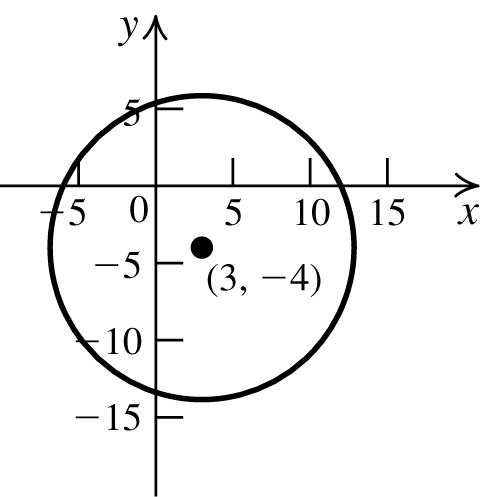
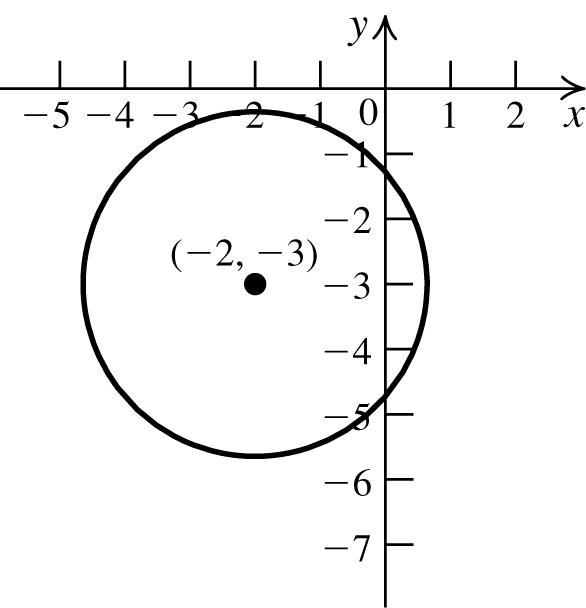
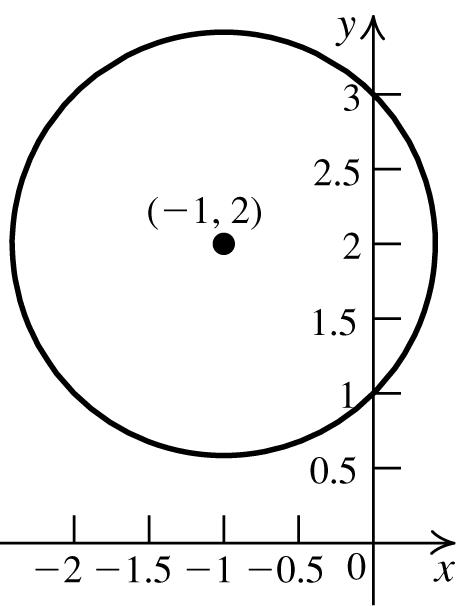
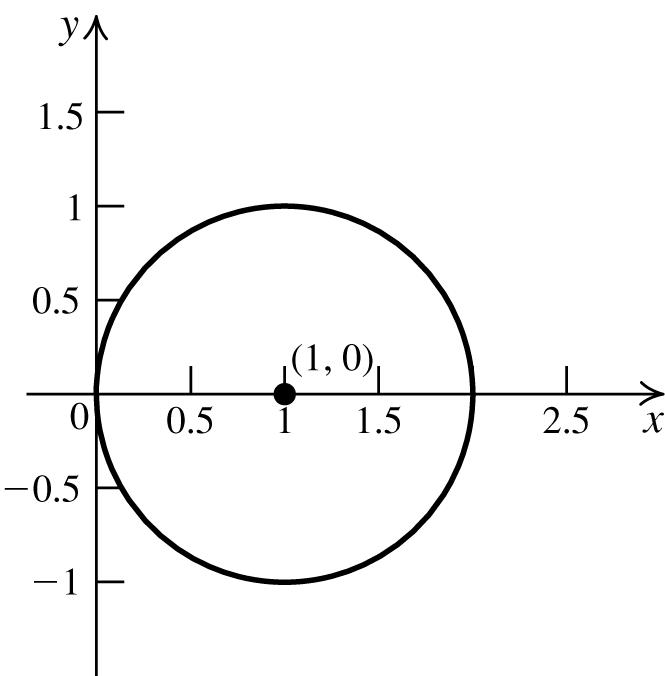
Copyright © 2015 Pearson Education Inc.

76. Find the radius by using the distance formula: 22 (12)(15)255 d =−−+−== . The equation of the circle is 22 (1)(1)25. xy++−=
80. Find the center by finding the midpoint of the diameter: ()2835,5,1 22 C +−+ ⎛⎞
Find the length of the radius by finding the length of the diameter and dividing that by 2. 22 (28)(35)10010 d =−+−−==
Thus, the length of the radius is 5, and the equation of the circle is 22 (5)(1)25. xy−+−=
77. The circle touches the x-axis, so the radius is 2. The equation of the circle is 22 (1)(2)4. xy−+−=
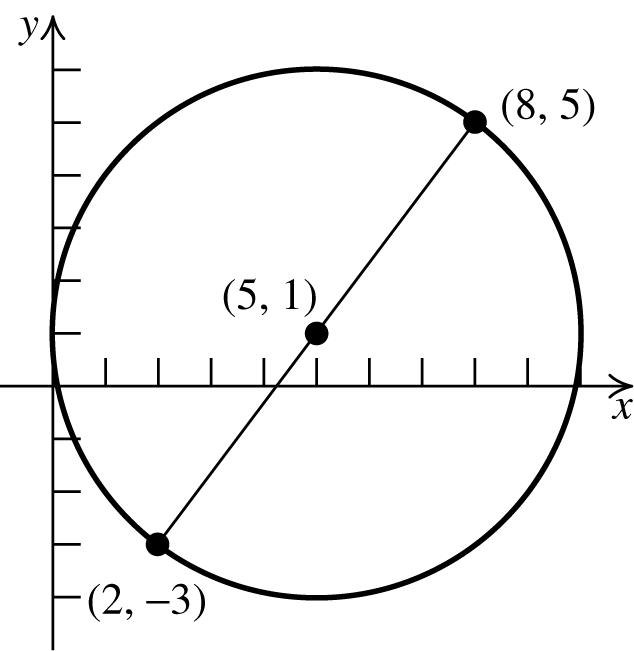
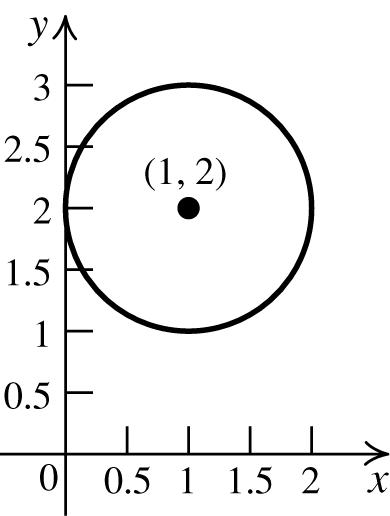
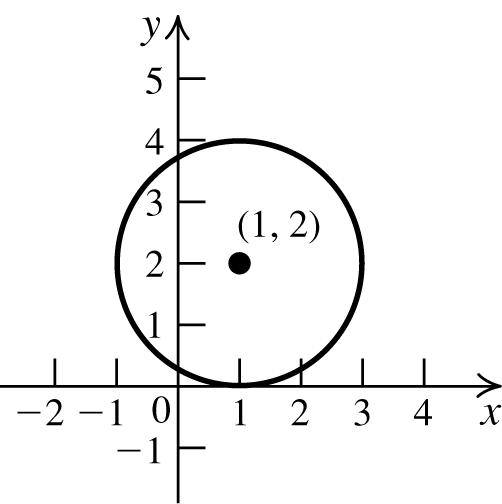
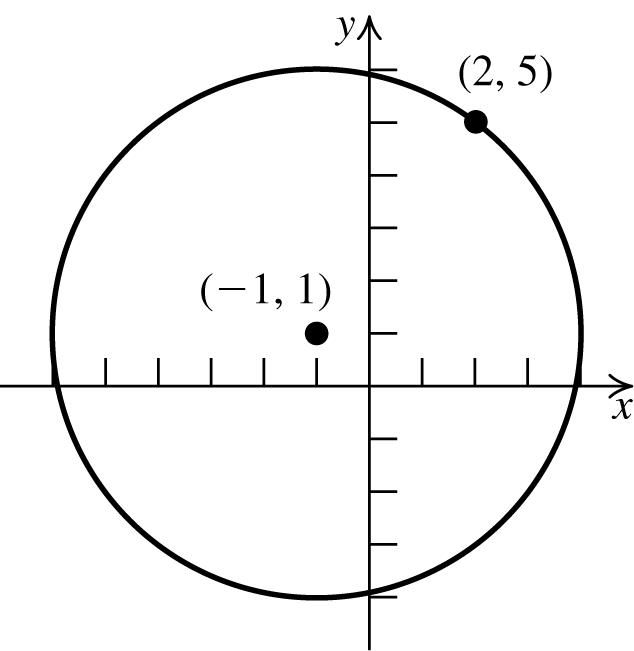
81. a. 22 2240xyxy+−−−=⇒
22224 xxyy−+−=
Now complete the square:
222121411 xxyy−++−+=++⇒
78. The circle touches the y-axis, so the radius is 1. The equation of the circle is 22 (1)(2)1 xy−+−= .
22 (1)(1)6 xy−+−= . This is a circle with center (1, 1) and radius 6.
b. To find the x-intercepts, let y = 0 and solve for x:
79. Find the diameter by using the distance formula:
22 (37)(64)104226 d =−−+−==
So the radius is 26. Use the midpoint formula to find the center:
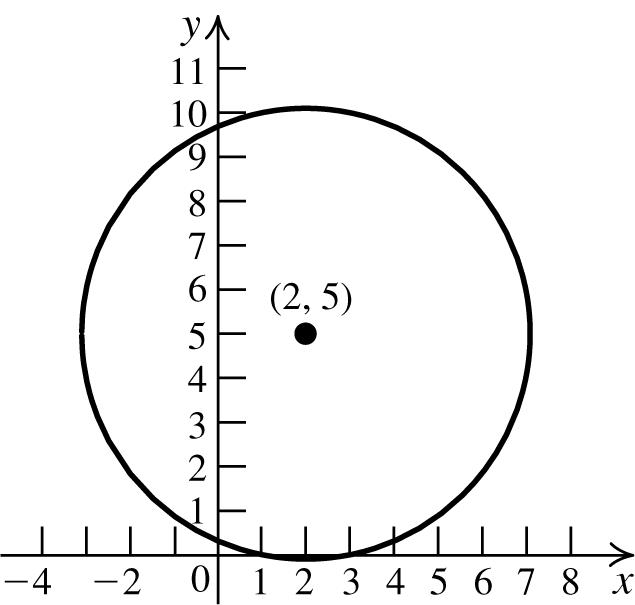
()7(3)46,2,5 22 M +−+ ⎛⎞ == ⎜⎟ ⎝⎠ . The equation of the circle is 22 (2)(5)26 xy−+−=
()
() 2 22 2 (1)(01)6116 151515 xx xxx −+−=⇒−+=⇒ −=⇒−=±⇒=±
Thus, the x-intercepts are ( ) 15,0 + and ( ) 15,0.
To find the y-intercepts, let x = 0 and solve for y:
() () 2 22 2 (01)(1)6116 151515 yy yyy −+−=⇒+−=⇒ −=⇒−=±⇒=±
Thus, the y-intercepts are ( ) 0,15 + and ( ) 0,15.
Copyright © 2015 Pearson Education Inc.
82. a. 22 42150xyxy+−−−=⇒
224215 xxyy−+−=
Now complete the square:
2244211541 xxyy−++−+=++⇒
22 (2)(1)20. xy−+−= This is a circle with center (2, 1) and radius 25.
b. To find the x-intercepts, let y = 0 and solve for x: 22 (2)(01)20 x −+−=⇒
()() 22 2120219 219219 xx xx −+=⇒−=⇒ −=±⇒=±
Thus, the x-intercepts are ( ) 219,0 + and ( ) 219,0.
To find the y-intercepts, let x = 0 and solve for y: 22 (02)(1)20 y −+−=⇒
() 2 2 4(1)20116 143,5 yy yy +−=⇒−=⇒ −=±⇒=−
Thus, the y-intercepts are (0, −3) and (0, 5).
83. a. 22 2240 xyy++=⇒
22 2(2)0 xyy++=⇒ 22 20.xyy++=
Now complete the square:
22222101(1)1. xyyxy +++=+⇒++=
This is a circle with center (0, –1) and radius 1.
b. To find the x-intercepts, let y = 0 and solve for x: 222(01)100 xxx ++=⇒=⇒=
Thus, the x-intercept is (0, 0). To find the y-intercepts, let x = 0 and solve for y:
22 0(1)1110,2 yyy ++=⇒+=±⇒=−
Thus, the y-intercepts are (0, 0) and (0, −2).
84. a. 22 3360 xyx++=⇒
22 3(2)0 xyx++=⇒ 2220.xxy++=
Now complete the square:
2222 2101(1)1.xxyxy +++=+⇒++=
This is a circle with center (–1, 0) and radius 1.
b. To find the x-intercepts, let y = 0 and solve for x:
22 (1)01110,2 xxx ++=⇒+=±⇒=−
Thus, the x-intercepts are (0, 0) and (−2, 0). To find the y-intercepts, let x = 0 and solve for y: 222 (01)100 yyy ++=⇒=⇒= Thus, the y-intercept is (0, 0).
85. a. 222200. xyxxxy+−=⇒−+= Now complete the square: 2211 0 44xxy−++=+⇒
2 2 11 . 24xy
This is a circle with center 1 ,0 2 ⎛ ⎞
and radius 1 2
b. To find the x-intercepts, let y = 0 and solve for x: 2 2 1111 0 2422 xx ⎛⎞−+=⇒−=±⇒
0,1. x = Thus, the x-intercepts are (0, 0) and (1, 0). To find the y-intercepts, let x = 0 and solve for y: 2 22 1111 0 2444 yy
2 00.yy=⇒= Thus, the y-intercept is (0, 0).
86. a. 2222101. xyxy++=⇒+=− The radius cannot be negative, so there is no graph.
b. There are no intercepts.
87. The distance from P(x, y) to the x-axis is x while the distance from P to the y-axis is . y So the equation of the graph is xy =
88. The distance from P(x, y) to (1, 2) is 22 (1)(2) xy−+− while the distance from P to (3, –4) is 22 (3)(4) xy−++
So the equation of the graph is 2222 (1)(2)(3)(4) xyxy −+−=−++⇒
2222 (1)(2)(3)(4) xyxy −+−=−++⇒
Copyright © 2015 Pearson Education Inc.
222144 xxyy−++−+=
2269816 xxyy−++++⇒
2456825 xyxy −−+=−++⇒
15 42012. 33xyyx −=⇒=−
89. The distance from P(x, y) to (2, 0) is 22 (2)xy −+ while the distance from P to the y-axis is x . So the equation of the graph is
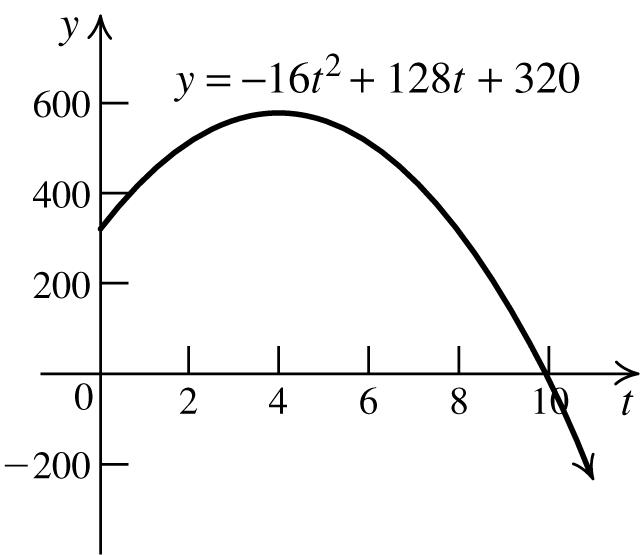

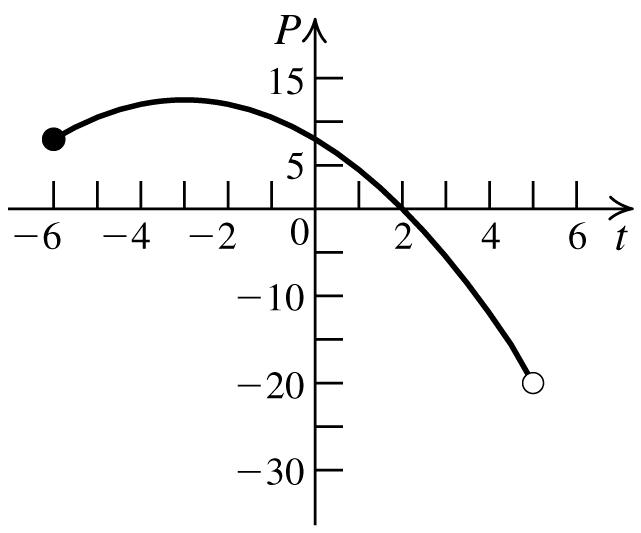
22222
d. To find the t-intercept, set P = 0 and solve for t: 2 00.538 tt =−−+⇒
±−−− ± == =−
2 3(3)4(0.5)(8) 325
The t-intercepts represent the months with no profit and no loss. In this case, t = −8 makes no sense in terms of the problem, so we disregard this solution. t = 2 represents Sept 2012.
2222 22
(2)(2) 4444 4 1 44
xyxxyx xxyxyx yy x
−+=⇒−+=⇒ −++=⇒=−⇒ + =+=
90. 2004 is the midpoint of the initial range, so 2004 136234 185. 2 M + ==
2002 is the midpoint of the range [2000, 2004], so 2002 136185 160.5. 2 M + ==
2006 is the midpoint of the range [2004, 2008], so 2006 185234 209.5. 2 M + ==
So, in 2002, $160.5 billion was spent, in 2004, $185 billion was spent and in 2006, $209.50 was spent.
91. a. Since July 2012 is represented by t = 0, March 2012 is represented by t = –4. So the monthly profit for March is determined by 2 0.5(4)3(4)8$12 P =−−−−+= million.
b. Since July 2012 is represented by t = 0, October 2012 is represented by t = 3. So the monthly profit for October is determined by 2 0.5(3)3(3)8$5.5 P =−−+=− million. This is a loss.
e. To find the P -intercept, set t = 0 and solve to P: 2 0.5(0)3(0)88.PP =−−+⇒= The P-intercept represents the profit in July 2012.
92. a.
b. To find the P -intercept, set t = 0 and solve to P: 2 0.002(0)0.51(0)17.5 P =−++⇒
17.5. P = The P-intercept represents the number of female college students in 2005.
93. a. t Height = 2 16128320 tt −++
Copyright © 2015 Pearson Education Inc.
d. To find the t-intercept, set y = 0 and solve for t:

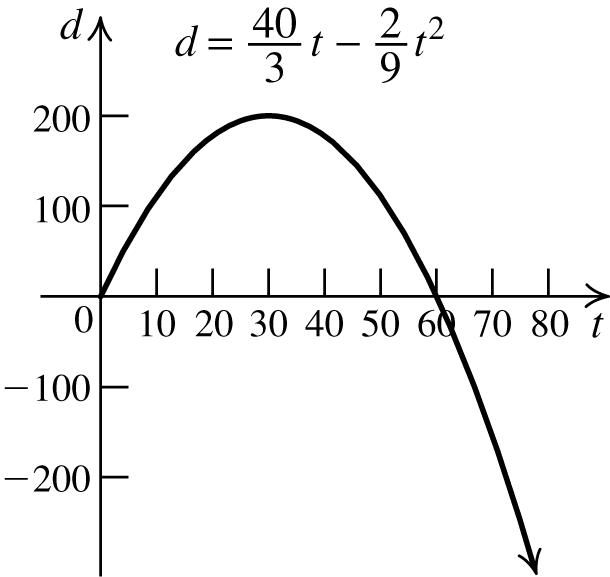
2 016128320 tt =−++⇒
2 016(820) tt =−−−⇒
0(10)(2) tt =−+⇒ 10 or 2. tt==−
The graph does not apply if t < 0, so the t-intercept is 10. This represents the time when the object hits the ground. To find the y-intercept, set t = 0 and solve for y:
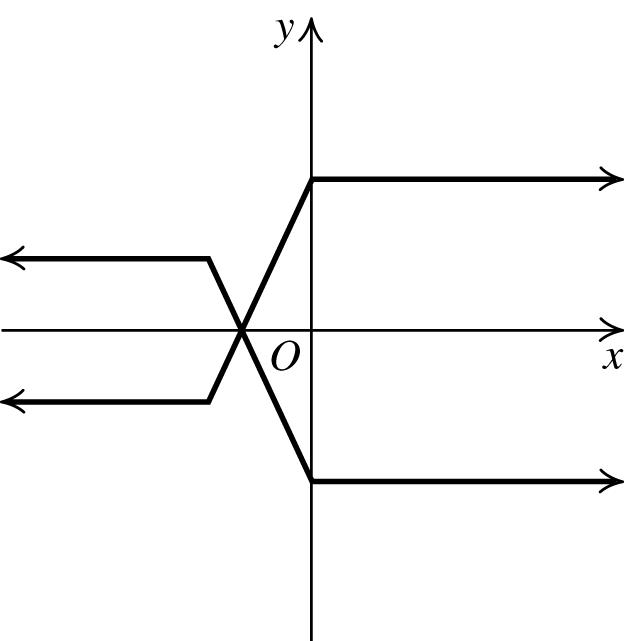
2 16(0)128(0)320320.yy =−++⇒=
This represents the height of the building.
a. b. 060 t ≤≤
c. The total time of the experiment is 60 minutes or 1 hour.
2.2 Beyond the Basics
So this is the graph of a circle with center (2, –1) and radius 5. The area of this circle is 25. π 22 42310xyxy+−+−=⇒
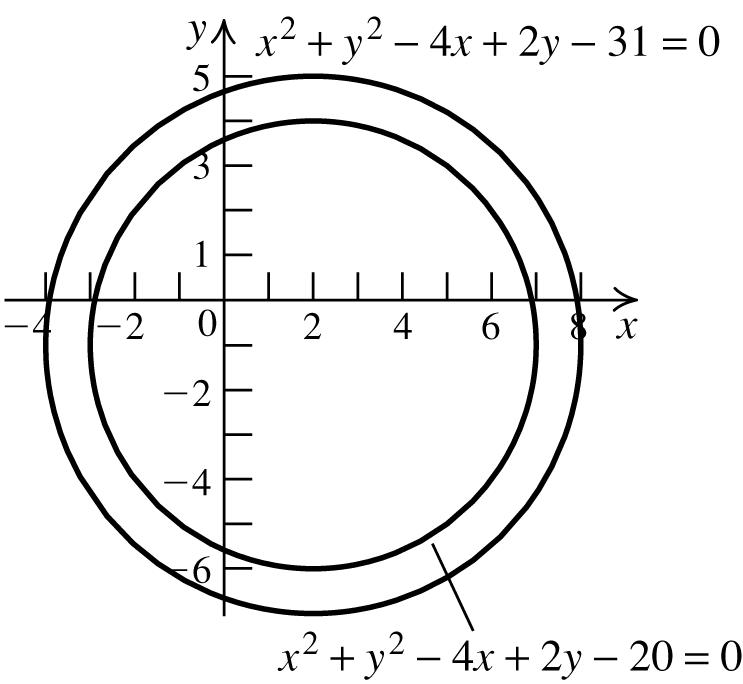
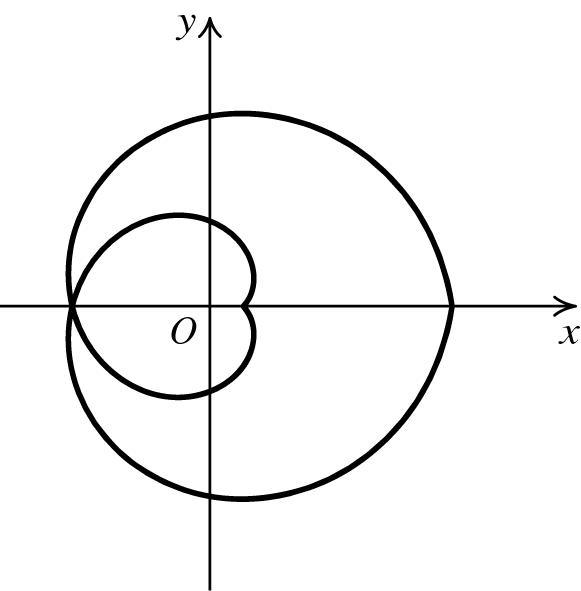

224231 xxyy−++=⇒
22 22 44213141 (2)(1)36 xxyy xy −++++=++⇒
So, this is the graph of a circle with center (2, –1) and radius 6. The area of this circle is 36. π Both circles have the same center, so the area of the region bounded by the two circles equals 362511. πππ −=
Copyright © 2015 Pearson Education Inc.
100. Using the hint, we know that the center of the circle will have coordinates (0, k).
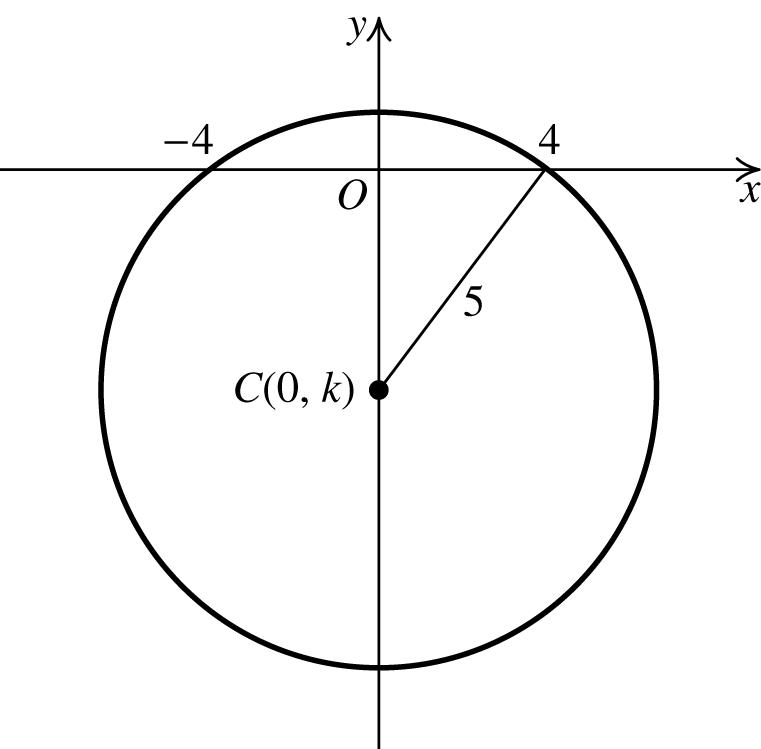
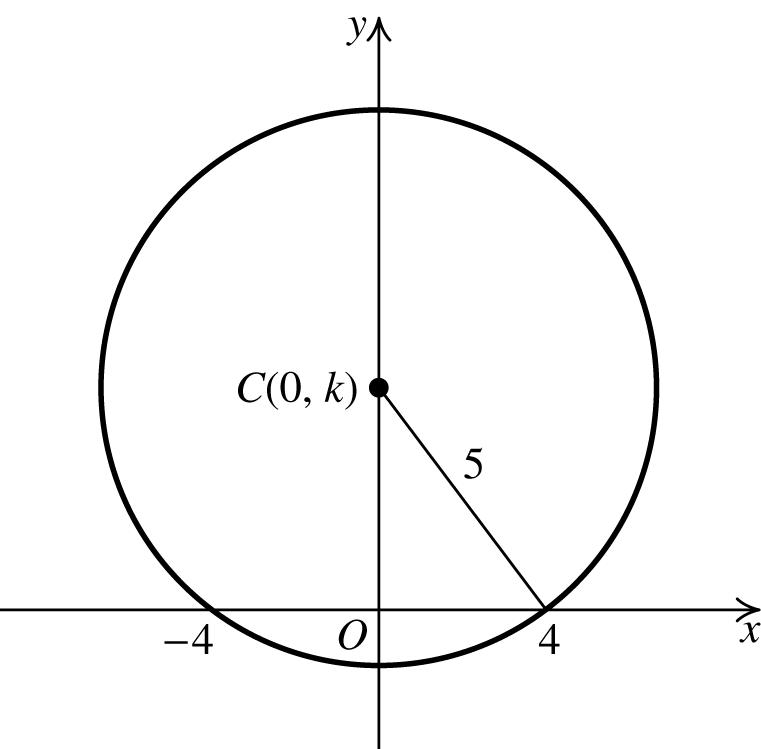
to the origin. The graph of 3 yx = is an example of a graph that is symmetric with respect to the origin but is not symmetric with respect to the x- and y-axes.
103. a. First find the radius of the circle: 22 (,)(60)(81)85dAB =−+−=⇒ 85 2 r =
The center of the circle is 6018 , 22 ++ ⎛ ⎞ = ⎜ ⎟ ⎝ ⎠ 9 3,. 2 ⎛⎞ ⎜⎟ ⎝⎠
So the equation of the circle is 2 2 985 (3). 24 xy⎛⎞ −+−= ⎜⎟
Use the Pythagorean theorem to find k. 222224516259
3 kkk k +=⇒+=⇒=⇒ =±
The equations of the circles are () 2 22 35. xy+±=
101. The graph of 2 2 yx = is the union of the graphs of 2 = yx and 2. =− yx

102. Let (x, y) be a point on the graph. Since the graph is symmetric with regard to the x-axis, then the point (x, –y) is also on the graph. Because the graph is symmetric with regard to the y-axis, the point (–x, y) is also on the graph. Therefore the point (–x, –y) is on the graph, and the graph is symmetric with respect
x xxx
985 (3)0 24 8185 (3)691 44 ⎛⎞ −+−=⇒ ⎜⎟ ⎝⎠ −+=⇒−+=⇒
2 680xx−+=
The x-intercepts are the roots of this equation.
b. First find the radius of the circle: 22 22 (,)(0)(1) (1) dABab ab =−+−
=+−⇒
⎛ ⎞⎛⎞
=
1(1) 0 224 (1)(1) 444 442121 4440 0
To find the x-intercepts, set y = 0 and solve for x: 22 22 2 222 2 22222 2 ⎛⎞⎛⎞++− ⎜⎟⎜⎟−+−= ⎝⎠⎝⎠ ++− −++= −++++=+−+ −+= −+=
xaxb
The x-intercepts are the roots of this equation.
Copyright © 2015 Pearson Education Inc.
c. a = 3 and b = 1. Approximate the roots of the equation by drawing a circle whose diameter has endpoints A(0, 1) and B(3, 1). The center of the circle is 3 ,1 2 ⎛⎞ ⎜⎟
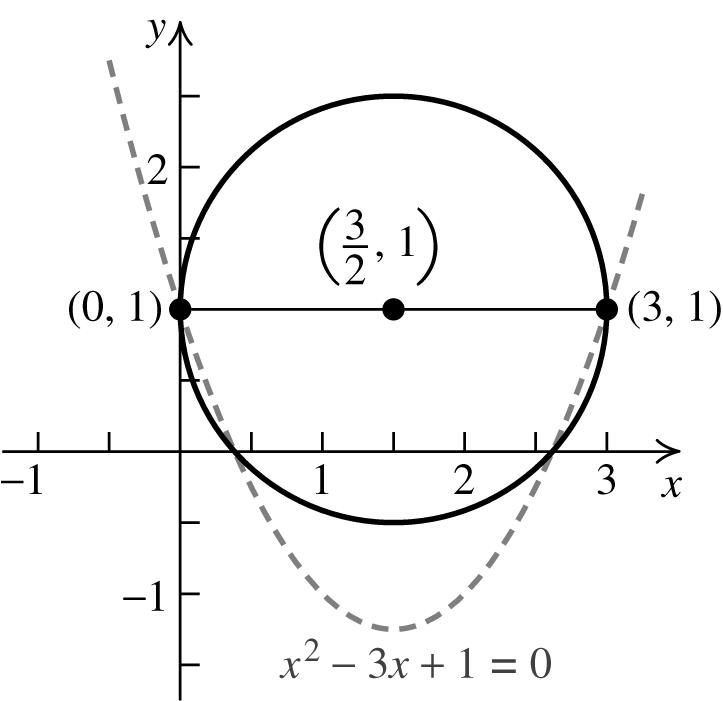
and the radius is 3 2 . The roots are approximately (0.4, 0) and (2.6, 0).
106. 1211 2244 ==
107. ( )23 51 313102 ==−
108. () 3121 2642 ==
==⋅=
5
110. () 31 1 13 44 3 111 44 263 ⎜⎟ ⎝⎠
104. a. The coordinates of the center of each circle are (r, r) and (3r, r).
111. () 1 1 A APPrtPrtP rt =+=+⇒= +
112. 236362 622 2 33
xyyx x yx
+=⇒=−⇒ ==−
113. 5 3315 25252 xyxy xy−=⇒−=⇒−=
b. To find the area of the shaded region, first find the area of the rectangle shown in the figure below, and then subtract the sum of the areas of the two sectors, A and B.

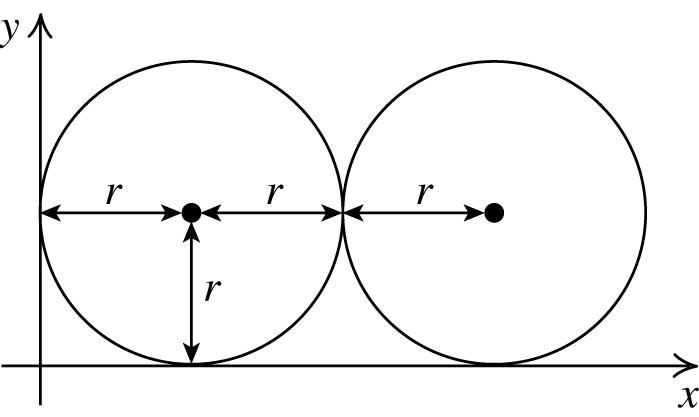
114. () ()
−−+=⇒
yx yxxx
=++=++=+
2 210 3 22228 212 33333
115. 0 axbycbyaxc ac yxbb =−−
116. 0.10.2102100 2100.55 xyxy yxyx +−=⇒+−=⇒
53 19 19 64 12 215 5 3412 ⎛⎞ ⎜⎟ ⎝⎠ −=−=−
Copyright © 2015 Pearson Education Inc.
2.3 Practice Problems
1. ( )53 8 7613 m ==−
A slope of 8 13 means that the value of y decreases 8 units for every 13 units increase in x
2. () 2 2,3, 3 Pm−−=−
3. () 4610 5 312 m ===
Use either point to determine the equation of the line. Using (−3, −4), we have ( ) ( ) ( )453453 4515511 yxyx yxyx
+=+⇒=+ Using (−1, 6), we have ( ) ( )651651 655511 yxyx yxyx
6. x = −3. The slope is undefined, and there is no y-intercept. The x-intercept is −3. y = 7. The slope is 0, and the y-intercept is 7.
7. First, solve for y to write the equation in slope-intercept form: 34244324 xyyx +=⇒=−+⇒
3 6 4 yx=−+ . The slope is 3 4 , and the y-intercept is 6. Find the x -intercept by setting y = 0 and solving the equation for x:
33 0668 44 =−+⇒=⇒= xxx . Thus, the graph passes through the points (0, 6) and (8, 0).
4. ( ) ( ) ( ) ()() 11 320 point-slope form 320 3223
yymxxyx yx yxyx
−=−⇒−−=− −−=−⇒ +=⇒=−
5. The slope is 2 3 and the y-intercept is 4. The line goes through (0, 4), so locate a second point by moving two units down and three units right. Thus, the line goes through (3, 2).
8. Use the equation 2.665Hx=+ ( ) () 1 2
2.64465179.4 H H =+= =+=
2.64365176.8
The person is between 176.8 cm and 179.4 cm tall, or 1.768 m and 1.794 m.
9. a. Parallel lines have the same slope, so the slope of the line is 3744 2533 m ===
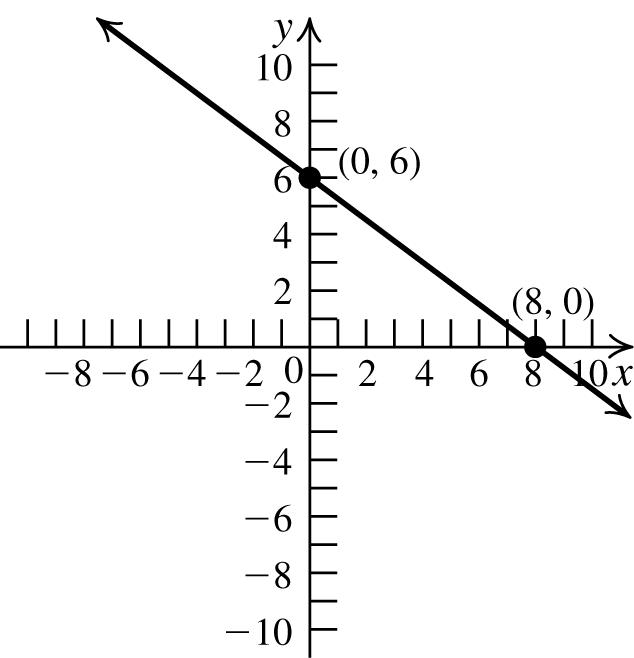


Using the point-slope form, we have
()() 4 5231542 3
−=⎡−−⎤⇒−=+⇒
−=+⇒−+=
Copyright © 2015 Pearson Education Inc.
b. The slopes of perpendicular lines are negative reciprocals. Write the equation 4510 xy++= in slope-intercept form to find its slope: 4510 xy++=⇒ 41
541 55yxyx =−−⇒=−− . The slope of a line perpendicular to this lines is 5 4 Using the point-slope form, we have
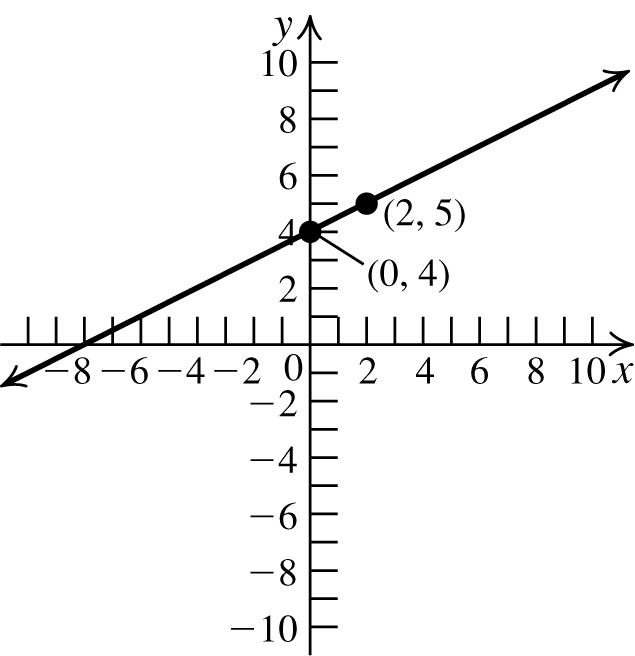
5 434453 4 41651554310 yxyx yxxy
−−=−⇒+=−⇒ +=−⇒−−=
10. Since 2014 is 8 years after 2006, set x = 8. Then y = 0.44(8) + 6.70 = 10.22 There were 10.22 million registered motorcycles in the U.S. in 2014.
1. The number that measure the “steepness” of a line is called the slope
2. In the slope formula, 21 21
yy m xx = , the number 21yy is called the rise
3. If two line have the same slope, then they are parallel
4. The y-intercept of the line with equation 35yx=− is −5.
5. A line perpendicular to a line with slope 1 5 has slope 5
6. True
7. False. The slope of the line through (1, 2) and (2, 4) is 42 2. 21 =
8. False. The slope of the line through (1, 3) and (2, y) is 3 3 21 y y =− . If y > 3, then the slope is positive.
9. 734 ; 413 m == the graph is rising.
10. 044 2; 202 m ===− the graph is falling.
11. 2(2)0 0; 268 m === the graph is horizontal.
12. 7(4)11 slope is undefined; 3(3)0 m ==⇒ the graph is vertical.
13. 3.525.5 2.2 30.52.5 m ===− ; the graph is falling.
14. 3(2)1 1 231 m === ; the graph is rising.
15. () 514 4 1 122 m === +− ; the graph is rising.
16. () () 330333 2 23 1313 m === +−− ; the graph is rising.
17. a. 3 b. 2 c. 4 d. 1
18. 1 passes through the points (2, 3) and (−1, 0). 1
03 1. 12 m ==
2 is a horizontal line, so it has slope 0
3 passes through the points (2, 3) and (0, −1). 3
13 2. 02 m ==
4 passes through the points (−6, 7) and (0, −1). () 4
174 . 063 m ==−
19. a. 0 y = b. 0 x =
20. a. 4 y =− b. 5 x =
21. 1 4 2 yx=+
Copyright © 2015 Pearson Education Inc.
22. 1 4 2 yx=−+
23. 33 1(2)13 22 yxyx −=−−⇒−=−+⇒ 3 4 2 yx=−+
26. Because the slope is undefined, the graph is vertical. The equation is 5. x =
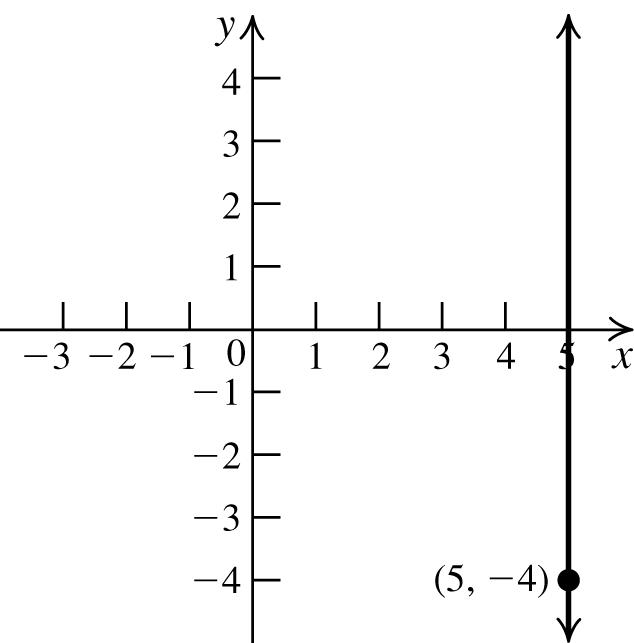

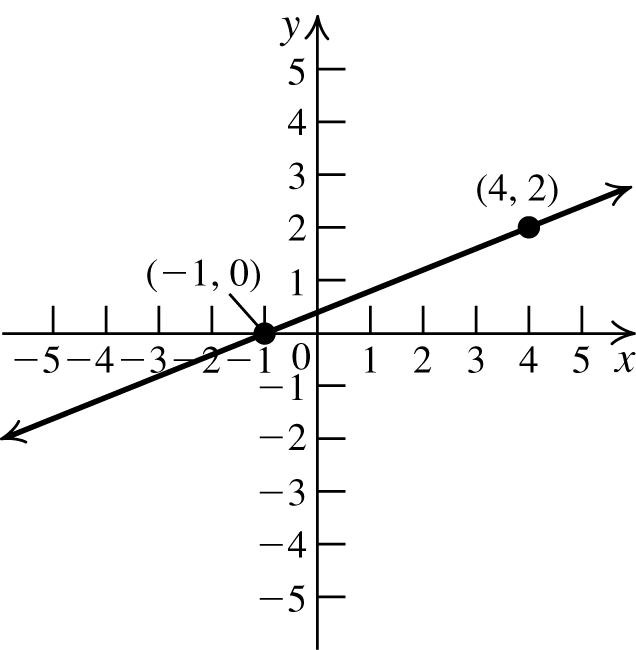

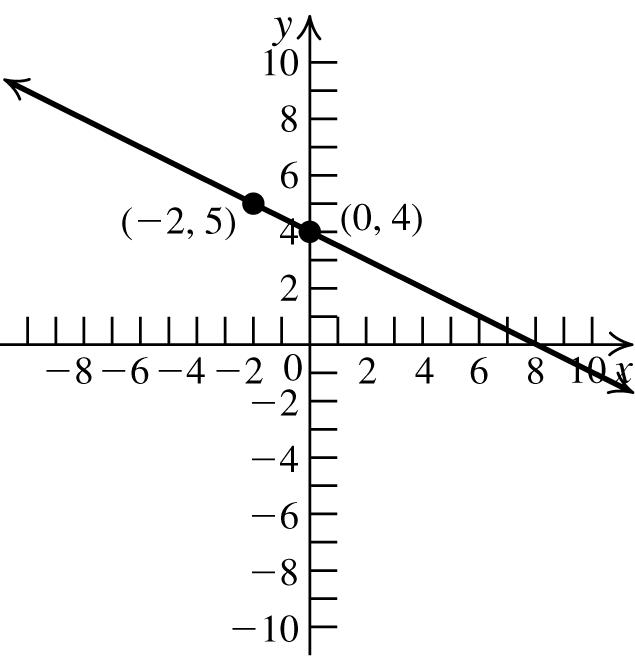
27. 01 1 10 m ==− . The y-intercept is (0, 1), so the equation is 1. yx=−+
28. 31 2 10 m == . The y-intercept is (0, 1), so the equation is 21.yx=+
29. 33 0 3(1) m == Because the slope = 0, the line is horizontal. Its equation is 3. y =
24. 222 (1) 555yxyx =+⇒=+
30. 716 2(5)7 m == . Now write the equation in point-slope form, and then solve for y to write the equation in slope-intercept form.
6 1(5) 7 −=+⇒yx 630 1 77 −=+⇒yx 637 77 =+yx
25. 40(5)404yxyy +=−⇒+=⇒=−
31. 1(1)2 1(2)3 m == . Now write the equation in point-slope form, and then solve for y to write the equation in slope-intercept form.
2 1(2) 3 +=+⇒yx 24 1 33 +=+⇒yx 21 33 =+yx
32. 9(3)6 6(1)7 m ==− . Now write the equation in point-slope form, and then solve for y to write the equation in slope-intercept form.
6 3(1) 7 +=−+⇒yx 66 3 77 +=−−⇒yx 627 77 =−−yx
Copyright © 2015 Pearson Education Inc.
33. 17 2 7 44 11 2 0 22
m ===− . Now write the equation in point-slope form, and then solve for y to write the equation in slope-intercept form. 77 22 22 −=−⇒=−+ yxyx
34. 3(7)10 440 m ==⇒ the slope is undefined. So the graph is a vertical line. The equation is 4. x =


35. 5 x = 36. 1.5 y =
37. 0 y = 38. 0 x =
39. 14 y = 40. 25yx=+
41. 2 4 3 yx=−− 42. 63yx=−−
43. 404 ; 0(3)3 m == 4 4 3 yx=+
44. 202 ; 0(5)5 m ==− 2 2 5 yx=−−
45. 7 y = 46. 4 x =
47. 5 y =− 48. 3 x =−
49. Two lines are parallel if their slopes are equal. The lines are perpendicular if the slope of one is the negative reciprocal of the slope of the other.
a.
2 21 154 2 312 m ===−⇒
b. 2
431 572 m ==− . The slope of 2 is neither equal to the slope of 1 nor the negative reciprocal of the slope of 1 Therefore, the lines are neither parallel nor perpendicular.
c. 2 21 431 422 m ==⇒⊥
50. 1 passes through the points (2, 3) and (−1, 0) and has slope 1. Its equation is ( ) 011yxyx −=−−⇒=+
2 has slope 0 and passes through ((−5, −4), so its equation is y = −4.
3 passes through the points (2, 3) and (0, −1) and has slope 2. Its equation is 21.yx=−
4 passes through the points (−6, 7) and (0, −1) and has slope 4 3 Its equation is 4 1. 3 yx=−−
51. 1 240242 2 xyyxyx +−=⇒=−+⇒=−+
The slope is 12 , and the y-intercept is (0, 2). To find the x -intercept, set y = 0 and solve for x: 2(0)404xx +−=⇒= .
52. 1 39933 3 xyxyyx =−⇒+=⇒=+
The slope is 13, and the y-intercept is (0, 3). To find the x -intercept, set y = 0 and solve for x: 3(0)99xx=−⇒=−
Copyright © 2015 Pearson Education Inc.
53. 3 32603623 2 xyxyxy −+=⇒+=⇒+=
The slope is 32, and the y-intercept is (0, 3). To find the x -intercept, set y = 0 and solve for x: 32(0)60362 xxx −+=⇒=−⇒=− .
56. 5 250 2 yy+=⇒=−
The slope is 0, and the y-intercept is 52 This is a horizontal line, so there is no x-intercept.
54. 24152154 xyxy =−+⇒−=−⇒ 115 24xy−+=
The slope is 12 , and the y-intercept is 154. To find the x -intercept, set y = 0 and solve for x: 24(0)15 x =−+⇒ 152 x =
57. 0 x =
The slope is undefined, and the y-intercepts are the y-axis. This is a vertical line whose x-intercept is 0.
55. 505xx−=⇒=
The slope is undefined, and there is no y-intercept. The x-intercept is 5.
58. 0 y =
The slope is 0, and the x-intercepts are the x-axis. This is a horizontal line whose y-intercept is 0.
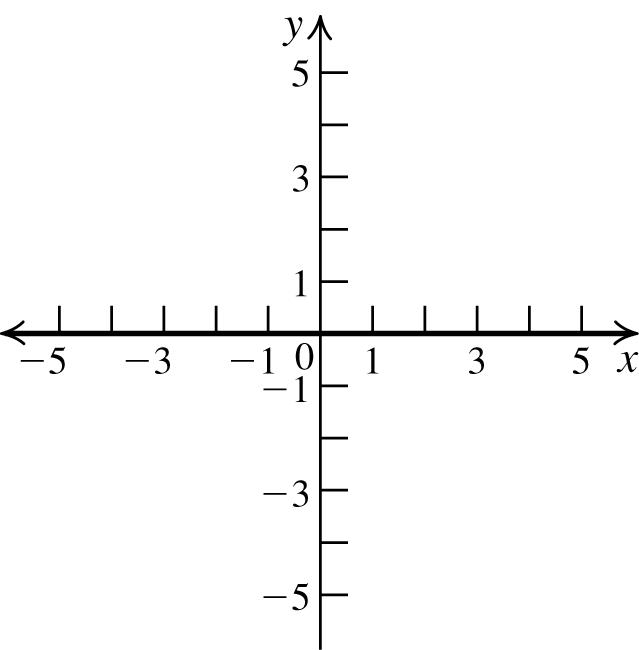




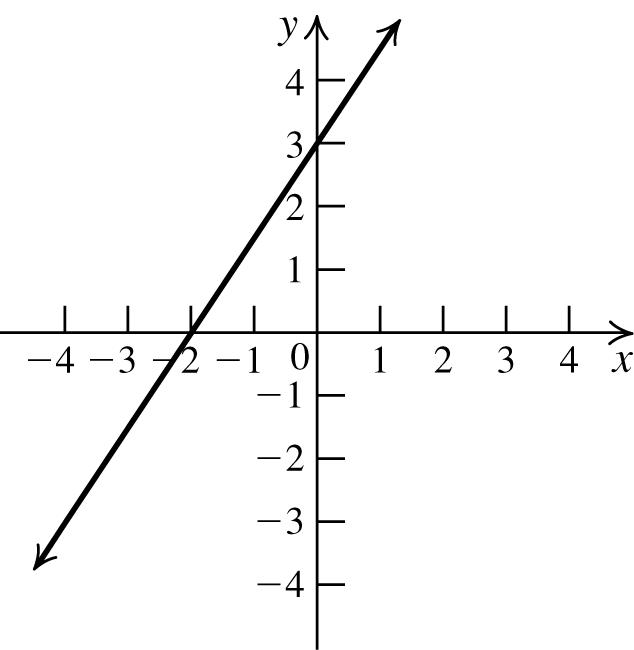
59. The slope of the line through ( a, 0) and (0, b) is 0 0 bb aa =− The equation of the line can be written as b ybxayabbx a −=−⇒−=−⇒
1 aybxabaybxabyx abababba +=⇒+=⇒+=
Copyright © 2015 Pearson Education Inc.
60. 1 43 xy+=
61. 236 2361; 66632 xyxy xy+=⇒+=⇒+=
x-intercept = 3; y-intercept = 2
62. 341203412 3412 1; 12121243
xyxy xyxy −+=⇒−=−⇒ −=⇒−+=
x-intercept = –4; y-intercept = 3
63. Let the intercepts be (a, 0) and (0, a). Then the equation of the line is 1. xy aa += Now substitute x = 3 and y = –5 into the equation to solve for a: 35 1352. aa aa −=⇒−=⇒−=
So the equation of the line is 1 22 xy −−=⇒
22.xyyx −−=⇒=−−
64. Let the intercepts be (a, 0) and (0, –a). Then the equation of the line is 1. xy aa −= Now substitute x = –5 and y = –8 into the equation to solve for a: 58 1583. aa aa −+=⇒−+=⇒= So the equation of the line is 1 33 xy−=⇒ 33.xyyx −=⇒=−
65. 945 1. 725 m === The equation of the line through (2, 4) and (7, 9) is 41(2)yx−=−⇒ y = x + 2. Check to see if (–1, 1) satisfies the equation by substituting x = –1 and y = 1: 11211. =−+⇒= So (–1, 1) also lies on the line. The points are collinear.
66. 325 1. 275 m === The equation of the line through (7, 2) and (2, –3) is 21(7)yx−=−⇒ 5. yx=− Check to see if (5, 1) satisfies the equation by substituting x = 5 and y = 1: 15510. =−⇒≠
So (5, 1) does not lie on the line. The points are not collinear.
67. The line with x -intercept −4 and passing through ( ) 1 2 ,9 has slope () 1 2
909 2. 92 4 m === Then the line
perpendicular to this line has slope 1 . 2 Since the line also passes through ( ) 1 2 ,9, its equation is 11 9 22yx ⎛ ⎞ −=−−⇒ ⎝ ⎠ 137 24yx=−+
68. The line through the origin has slope 4 2. 2 = Then the line parallel to this line also has slope 2. The line passes through (−2, 0), so its equation is ( ) ( ) 02224yxyx −=−−⇒=+
69. Both lines are vertical lines. The lines are parallel.
70. 0 x = is the equation of the y-axis. 0 y = is the equation of the x-axis. The lines are perpendicular.
71. The slope of 237 xy+= is 23 , while 2 y = is a horizontal line. The lines are neither parallel nor perpendicular.
72. The slope of 31yx=+ is 3. The slope of 620 yx+= is 13 . The lines are perpendicular.
73. The slope of 48xy=+ is 14. The slope of 41yx=−+ is 4 , so the lines are perpendicular.
74. The slope of 431 xy+= is 43 , while the slope of 32yx+= is 2. The lines are neither parallel nor perpendicular.
75. The slope of 387 xy+= is 38 , while the slope of 570 xy−= is 57. The lines are neither parallel nor perpendicular.
76. The slope of 1023 xy+= is 5 . The slope of 15 yx +=− is also 5 , so the lines are parallel.
77. a. Use the point-slope form.
) ( ) 332336 39 yxyx yx −−=−⇒+=−⇒ =−
Copyright © 2015 Pearson Education Inc.
b. The slope of the line we are seeking is 2. Using the point-slope form, we have ( ) ( ) ( )221221 22224 yxyx yxyx −=−−⇒−=+⇒ −=+⇒=+
78. a. The slope of the line we are seeking is () 224 1. 134 ==−
Using the point-slope form, we have ( ) ( ) ( ) ( ) 5252 527 yxyx yxyx −−=−−−⇒+=−+⇒ +=−−⇒=−−
83. The slope of the line 65yx=+ is 6. The lines are perpendicular, so the slope of the new line is 16 . The equation of the line with slope 16 and y-intercept 4 is 1 4 6 yx=−+ .
84. The slope of 2370 xy −+−= is 23. The lines are parallel, so they have the same slope. The equation of the line through (1, 0) with slope 23 is 222 0(1)333yxyx −=−⇒=−
yxyx yx
−−=−−⇒+=−+⇒ =−−
b. The slope of the given line is ( ) () 21 3 3, 341 == so the slope of the line we are seeking is 1 . 3 Using the point-slope form, we have () () 111 212 333 15 33
79. The slope of x + y = 1 is −1. The lines are parallel, so they have the same slope. The equation of the line through (1, 1) with slope −1 is 1(1)yx−=−−⇒ 11yx−=−+⇒ 2 yx=−+ .
80. The slope of 65yx=+ is 6. The lines are parallel, so they have the same slope. The equation of the line with slope 6 and yintercept 2 is 62yx=− .
81. The slope of 3918 xy−= is 13. The lines are perpendicular, so the slope of the new line is 3 . The equation of the line through (–2, 4) with slope 3 is 43((2))yx−=−−−⇒
43632yxyx −=−−⇒=−−
82. The slope of 214 xy −+= is 2. The lines are perpendicular, so the slope of the new line is 12 . The equation of the line through (0, 0) with slope 12 is () 1 00 2 yx−=−−⇒
85. The slope of AB is () 352 , 213 =− so the slope of its perpendicular bisector is 3 . 2 The midpoint of AB is ( )21 351 ,,4. 222
Using the point-slope form, the equation of the perpendicular bisector is 3133 44 2224 313
86. The slope of AB is 1, ba ab =− so the slope of its perpendicular bisector is 1. The midpoint of AB is 22,. abba ++ ⎛ ⎞ ⎜ ⎟ ⎝ ⎠
Using the point-slope form, the equation of the perpendicular bisector is 22 baab yxyx ++ −=−⇒=
87. slope = rise41 run4010 ⇒=
88. 4 miles = 21,120 feet. slope = rise run ⇒
200025
21,120264 =
89. a. x = the number of weeks; y = the amount of money in the account after x weeks;
7130yx=+
Copyright © 2015 Pearson Education Inc.
b. The slope is the amount of money deposited each week; the y-intercept is the initial deposit.
90. a. x = the number of sessions of golf; y = the yearly payment to the club; 351000yx=+
b. The slope is the cost per golf session; the y-intercept is the yearly membership fee.
91. a. x = the number of hours worked per week; y = the amount earned per week;
To compute the salary when x > 40, use the following steps: For 40 hours, Judy earns 40(11) = $440. The number of overtime hours is x – 40. For those hours, she earns (1.5)(11)(x – 40) = 16.5x – 660. So her total wage is 440 + 16.50x – 660 = 16.5x – 220.
b. The slope is the hourly wage; the y-intercept is the wage for 0 hours of work.
92. a. x = the number of months owed to pay off the refrigerator; y = the amount owed; 15600yx=−+
b. The slope is the amount paid each month; the y-intercept is the down payment.
93. a. x = the number of rupees; y = the number of dollars equal to x rupees.
b. The slope is the number of dollars per rupee. When x = 0, y = 0.
94. a. x = the number of years after 2010; y = the life expectancy of a female born in the year 2010 + x; 0.1780.8yx=+
b. The slope is the rate of increase in life expectancy; the y-intercept is the current life expectancy of a female born in the U.S. in 2010.
95. a. The y-intercept represents the initial value of the machine, $9000.
b. The point (10, 1) gives the value of the machine after 10 years as $1000.
c. The value of the machine decreased from $9000 to $1000 over 10 years. This is a decrease of 900010008000 $800 1010 == per year.
d. Using the points (0, 9) and (10, 1), the slope is 91 0.8 010 =−
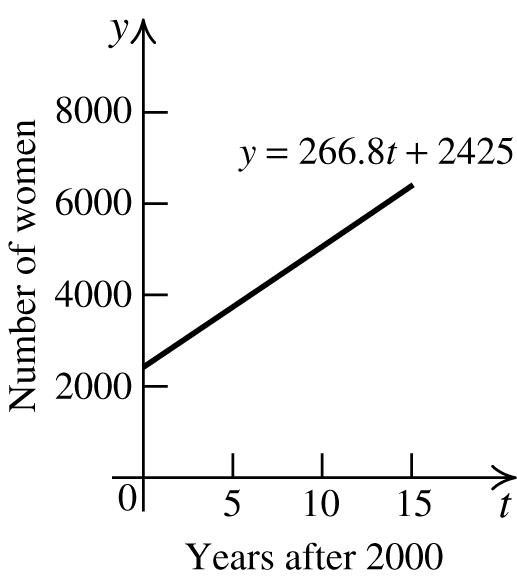

( ) 90.800.89yxyx −=−−⇒=−+
e. The slope gives the machine’s yearly depreciation, −0.8(1000) = −800.
96. a. 1400(2)14,000$11,200 v =−+=
b. 1400(6)14,000$5600 v =−+=
To find when the tractor will have no value, set v = 0 and solve the equation for t: 0140014,00010 tt =−+⇒=
97. 540,000yx=+
98. a. 0.2530Cx=+
b.
c. 0.25(60)30$45 y =+=
d. 47.750.253071 miles xx =+⇒=
99. a. The year 2005 is represented by t = 0, and the year 2011 is represented by t = 6. The points are (0, 2425) and (6, 4026). So the slope is 40262425 266.8 6 ≈
The equation is 2425266.8(0)yt −=−⇒ 266.82425yt=+
b.
c. The year 2008 is represented by t = 3. So 266.8(3)24253225.4yy =+⇒=
Note that there cannot be a fraction of a person, so. there were 3225 women prisoners in 2008.
Copyright © 2015 Pearson Education Inc.
d. The year 2017 is represented by t = 12. So 266.8(12)24255626.6yy =+⇒= . There will be 5627 women prisoners in 2017.
100. a. The two points are (100, 212) and (0, 32). So the slope is 212321809 . 10001005 ==
The equation is 99 32(0)32 55 FCFC −=−⇒=+
b. One degree Celsius change in the temperature equals 95 degrees change in degrees Fahrenheit.
c. C 9 32 5 FC=+
40º C 104º F
25º C 77º F
–5º C 23º F
–10º C 14º F
d. 9 100F3237.7838C 5 CC °=+⇒=≈°
9 90F3232.2232C 5 CC °=+⇒=≈°
9 75F3223.8924C 5 CC °=+⇒=≈°
9 10F3223.3323C 5 CC −°=+⇒=−≈−°
9 20F3228.8929C 5 CC −°=+⇒=−≈−°
e. 9 97.6F3236.44C 5 CC °=+⇒=° ; 9 99.6F3237.56C 5 CC °=+⇒=°
Normal body temperature ranges from 36.44°C to 37.56°C.
f. Let x = °F = °C. Then 9 32 5 xx=+⇒ 4 3240 5 xx −=⇒=− . At –40°, °F = °C
101. a. The two points are (4, 210.20) and (10, 348.80). So the slope is 348.80210.20138.6 23.1
1046 == .
The equation is 348.823.1(10)yx −=−⇒ 23.1117.8yx=+
b. The slope represents the cost of producing one modem. The y-intercept represents the fixed cost.
c. 23.1(12)117.8$395yy =+⇒=
102. a. The two points are (5, 5.73) and (8, 6.27).
The slope is 6.275.730.54 0.18 853 ==
The equation is 5.730.18(5)yx −=−⇒ 0.184.83.yx=+
b. The slope represents the monthly change in the number of viewers. The y-intercept represents the number of viewers when the show first started.
c. 0.18(11)4.836.81yy =+⇒= million
103. The independent variable t represents the number of years after 2005, with t = 0 representing 2005. The two points are (0, 12.7) and (3, 11.68). So the slope is 12.711.68 0.34 3 =− . The equation is 12.70.34(0)0.3412.7. ptpt −=−−⇒=−+ The year 2013 is represented by t = 8. ( ) 0.34812.79.98%.pp =−+⇒=
104. The year 2004 is represented by t = 0, so the year 2009 is represented by t = 5. The two points are (0, 82.7) and (5, 84.2). So the slope is 84.282.71.5 0.3 55 == .
The equation is 0.382.7.yt=+
105. a.
212.4yx=−+
Copyright © 2015 Pearson Education Inc.

b. [0, 6, 1] by [0, 12, 1]
c. The price in the table is given as the number of nickels. 35¢ = 7 nickels, so let x = 7. ( ) 2712.41.6 y =−+=−
Thus, no newspapers will be sold if the price per copy is 35¢. Note that this is also clear from the graph, which appears to cross the x -axis at approximately x = 6.
108. a. Let A = (1, 0.5), B = (2, 0), C = (0.5, 0.75). 00.50.750 0.5;0.5 210.52ABBC mm==−==− 0.750.5 0.5 0.51 AC m ==−
The slopes of the three segments are the same, so the points are collinear.
dBC ⎛ =−+−⎞⎛⎞
106. a.
⎠⎝⎠ == 13122 (,)1242 55 164 dAC ⎛ =−+−⎞⎛⎞
0.0910.3yx≈+
b. [0, 700, 100] by [0, 80, 10]
c. The advertising expenses in the table are given as thousands of dollars, so let x = 700. ( ) 0.0970010.373.3 y ≈+= Sales are given in thousands, so approximately 73.3100073,300 ×= computers will be sold.
107. a. Let A = (0, 1), B = (1, 3), C = (–1, –1). 31134 2;2 10112ABBCmm===== 11
2 10 AC m == . The slopes of the three segments are the same, so the points are collinear.
b. 22 22 (,)(10)(31)5 (,)(11)(13)25 =−+−= =−−+−−= dAB dBC 22 (,)(10)(11)5 =−−+−−= dAC
Because d(B, C) = d(A, B) + d(A, C), the three points are collinear.
109. Since the points are collinear, the slope is the same no matter which two points are used to determine the slope. So we have
=⇒=⇒
() ()
()
cc cc cc
−=−⇒−=−⇒ =−⇒=−
12113 154569 91189918 991
111 5 22651 24222 11 222 222 242263
=⇒=⇒
cc c c ccc
=⇒−=⇒ −=⇒=⇒=
The product of the slopes = –1, so , ABBC ⊥ and the triangle is a right triangle.
Copyright © 2015 Pearson Education Inc.
b. 22 22 22
dAB dBC dAC
(,)(11)(41)13 (,)(5(1))(84)52
(,)(51)(81)65
=−−+−= =−−+−= =−+−=
()()() 222 (,)(,)(,), dABdBCdAC += so the triangle is a right triangle.
mm mm
ABBC CDAD
====− ====−
112. 2(1)3121 ; 1(4)5312 2132(1)1 ; 2352(4)2
So, and , ABCDBCAD and ABCD is a parallelogram.
113. The equation of 1 is 11ymxb =+ and the equation of 2 is 22 . ymxb =+ Let ( ) 11 , xy and ( ) 22 , xy be on 1 If 12 , then the distance between them is 12bb In other words, ( ) ( ) 1112 , xybb and ( ) ( ) 2212 , xybb are on 2 . So, ( ) 1122121121 ybbmxbybmx −−=+⇒−=⇒
1211 ymxb =+ However, ( ) 11 , xy lies on 1 So 121111121 ymxbmxbmm =+=+⇒= 114.
dABxy xy y mxy x yx 42 (2)2156.25 33 48 (2)156.25 33
==−+−⇒ −+−= ==⇒−=−⇒ xx xx
⎛⎞ ⎛⎞ −+−−= ⎜⎟ ⎜⎟ ⎝⎠ ⎝⎠ ⎛⎞ −+−= ⎜⎟ ⎝⎠ 22 22 2
xxxx xxxx xx
166464 44156.25 −++−+= −++−+= −−=
999 936361664641406.25 251001306.250
Solve this equation using the quadratic formula: 2 1001004(25)(1306.25)
2(25) 10010,000130,625 50
9.5 or 5.5 5050 x ±−− = ±+ = ±± ===−
12
yyxx xxyy =−⇒
1212 ()()()() yyyyxxxx −−=−−−⇒
1212 ()()()()0. xxxxyyyy −−+−−=
117. Write the equations of each circle in standard form to find the centers.
22
( ) ( )
++−= (continuedonnextpage)
Copyright © 2015 Pearson Education Inc.
22 22 22
The centers are (−3, 7) and (2, −5). Using the result from exercise 116, we have (
Since the tangent line ℓ is perpendicular to OP , the slope of ℓ is the negative reciprocal of 12 5 or 5 12 . Using the point-slope form, we have
5255169 12 12121212yxyx −=+⇒=+
119. The tangent line at a point is perpendicular to the radius drawn to that point. The center of 22 25 xy+= is (0, 0), so the slope of the radius is 3 4 and the slope of the tangent is 4
122.
123.
()() ()()
xyxy xxyy xy++−=
46120 44691249 2325
++−−=⇒ +++−+=++⇒
yxyx yx
−−=−⇒+=−⇒ =−
3 Using the point-slope form, the equation of the tangent is () () 4416 343 333 425 33
124.
−=−−⇒−=−+⇒
yxyx yx
=−+
The center of the circle is (−2, 3). The slope of the radius is () 734 123 = and the slope of the tangent is 3 4 Using the point-slope form, the equation of the tangent is () 333 717 444 331 44

The family of lines has slope 2. The lines have different y-intercepts.
The family of lines has y -intercept 2. The lines have different slopes.
The lines pass through (1, 0). The lines have different slopes.
The lines pass through (−1, −2). The lines have different slopes.
Copyright © 2015 Pearson Education Inc.
125. a.
126.
This is a family of lines parallel to the line 2.yx =− They all have slope –2. b.

127. ()() 2 20210 2,1 xxxx x −−=⇒−+=⇒ =−
Solution set: {−1, 2}
128. ()() 2 230310 3,1 xxxx x +−=⇒+−=⇒ =−
Solution set: {−3, 1}
129. ()()
xx xx x xxx
2 2 56 0560 1 2302,3
++ =⇒++=⇒ ++=⇒=−−
Solution set: {−3, −2}
This is a family of lines that passes through the point (0, –4).
a. If 12 0 mm>> and 12 , bb > then 2112 1212
bbbb x mmmm ==−
b. If 12 0 mm>> and 12 , bb < then 21 12 . bb x mm =
c. If 12 0 mm<< and 12 , bb > then 2112 1221
bbbb x mmmm ==
d. If 12 0 mm<< and 12 , bb < then 2121 1221 . bbbb x mmmm ==−
130. ( ) ( ) ()() ()()
2 2 3121 61 00 43 12 11 31210, 32
xxxx xxxx xxx
+− =⇒=⇒ −+ +−=⇒=−
Solution set: 11 , 32 ⎧⎫
131. ()() 2 560320xxxx−+≥⇒−−≥
Now solve the associated equation: ( ) ( ) 3203 or 2. xxxx −−=⇒==

So, the intervals are ( ] [ ] [ ) ,2,2,3,and 3,.−∞∞
The
132. 112 100 22 21 0 2
xxx xx x x
−−++ +≥⇒≥⇒ ++ + ≥ +
Now solve 1 2 210xx+=⇒=− and 20 x +=⇒ 2. x =−
So the intervals are ( ) ,2,−∞− ( 1 2 2,, and ⎤ ⎦ ) 1 2 ,. ⎡ −∞ ⎣ The original fraction is not defined if x = −2, so −2 is not included in the intervals.
(continuedonnextpage)
Copyright © 2015 Pearson Education Inc.
1.a. The domain of R is {2, −2, 3} and its range is {1, 2}. The relation R is a function because no two ordered pairs in R have the same first component.
b. The domain of S is {2, 3} and its range is {5, −2}. The relation S is not a function because the ordered paired (3, −2) and (3, 5) have the same first component.
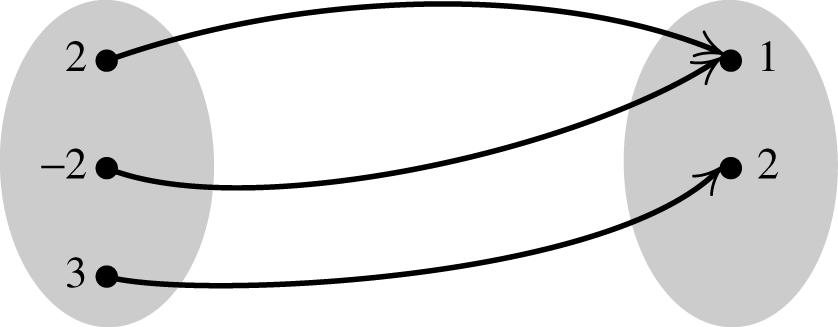
2. Solve each equation for y.
a. 21212222 xyxy−=⇒−=⇒ 2 21xy±−= ; not a function
b. () 1 25525 2 xyxyxy −=⇒−=⇒−= ; a function
3.a. ()()() 2 020500 g =−+=
b. ()()() 2 121517 g −=−−+−=−
c. ()()()
+=−+++ =−++++ =−−+−+
25 2255 24525
gxhxhxh xxhhxh xhxxhh
() 2 22 22
4. ( ) ( ) ( ) ( )
()() lengthheight3122 22244 sq. units TLMSA ==− ==
5.a. () 1 1 fx x = is not defined when 101 xx −=⇒= or when101. xx−<⇒< Thus, the domain of f is ( ),1−∞
b. () 2 3 fxx x + = is not defined when the denominator equals 0 or when 2 0. 3 x x + < 2 0 3 x x + < for (−2, 3), so this interval is not in the domain of f. The denominator 303,xx−≤⇒≤ so all numbers less than or equal to 3 are not in the domain of f. Thus, the domain of f is ( ] ( ) ,23,.−∞−∞ ∪
6. () 2 , fxx = domain X = [−3, 3]
a. () 2 1010103.16fxxx=⇒=⇒=±≈± Since 103 > and 103,−<− neither solution is in the interval X = [−3, 3]. Therefore, 10 is not in the range of f

b. () 2 442fxxx=⇒=⇒=±
Since −3 < −2 < 2 < 3, 4 is in the range of f.
c. The range of f is the interval [0, 9] because for each number y in this interval, the number xy = is in the interval [−3, 3].
7.
The graph is not a function because a vertical line can be drawn through three points, as shown.
8. () 2 45yfxxx ==+−
a. Check whether the ordered pair (2, 7) satisfies the equation: () ? 2 72425 77 =+− =
The point (2, 7) is on the graph.
b. Let y = −8, then solve for x: ()() 22 845043 0313 or 1 xxxx xxxx −=+−⇒=++⇒ =++⇒=−=−
The points (−3, −8) and (−1, −8) lie on the graph.
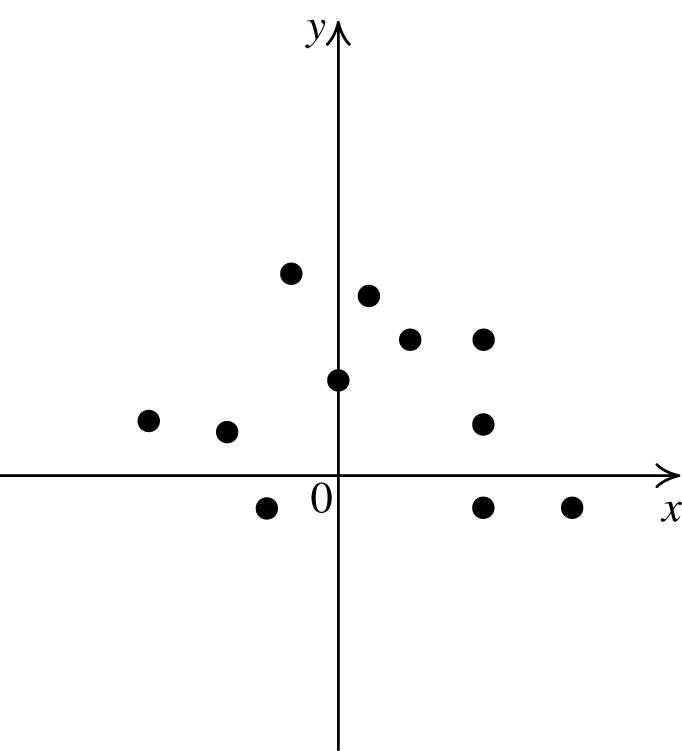
c. Let x = 0, then solve for y: () 2 04055 y =+−=−
The y-intercept is −5.
d. Let y = 0, then solve for x: ()() 2 045051 5 or 1 xxxx xx =+−⇒=+−⇒ =−=
The x-intercepts are −5 and 1.
9.
Domain: ( ) 3,;−∞ range: ( ] { }2,23 ∪
10. The range of C(t) is [6, 12). ( ) ( ) ( ) 11 22 1110611.988611.994CC=+=+= .
11. From Example 11, we have 22 500 APx =+ and 1200 PDx =− feet. If c = the cost on land, the total cost C is given by ( ) ( ) () 22 1.3 1.35001200 CcPDcAP cxcx
=+ =++−
12.a. ( ) 1200100,000Cxx=+
b. ( ) 2500 Rxx =
c. ( ) ( ) ( )
PxRxCx xx x
=− =−+ =−
() 25001200100,000
1300100,000
d. The break-even point occurs when ( ) ( ) = CxRx .
1200100,0002500
100,000130077 xx xx += =⇒≈ Metro needs 77 shows to break even.
1. In the functional notation ( ) yfx = , x is the independent variable.
2. If (2)7 f −= , then −2 is in the domain of the function f, and 7 is in the range of f
3. If the point (9, −14) is on the graph of a function f, then (9)14. f =−
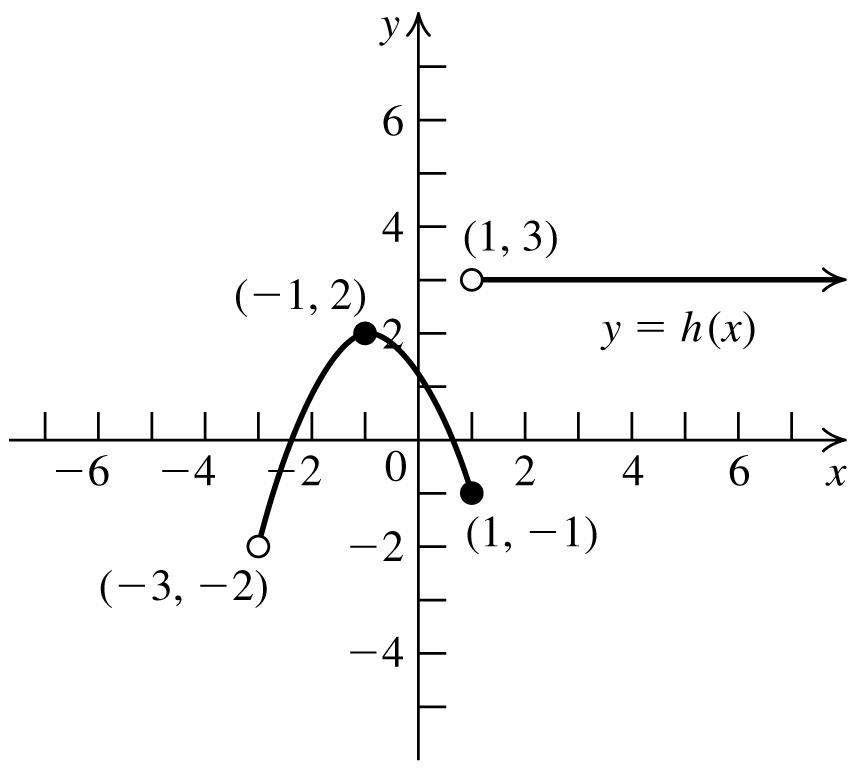
4. If (3, 7) and (3, 0) ar both points on a graph, then the graph cannot be the graph of a function.
5. To find the x -intercepts of the graph of an equation in x and y, we solve the equation y = 0.
Copyright © 2015 Pearson Education Inc.
6. False. For example, if () 1 , fx x = then a = 1 and b = −1 are both in the domain of f However, a + b = 0 is not in the domain of f.
7. True. −x = 7 and the square root function is defined for all positive numbers.
8. False. The domain of f is all real x for x > −2. Values of x ≤ −2 make the square root undefined.
9. Domain: {a, b, c}; range: {d, e}; function
10. Domain: {a, b, c}; range: {d, e, f}; function
11. Domain: {a, b, c}; range: {1, 2}; function
12. Domain: {1, 2, 3}; range: {a, b, c, d}; not a function
13. Domain: {0, 3, 8}; range:{ –3, –2, –1, 1, 2}; not a function
14. Domain: {–3, –1, 0, 1, 2, 3}; range: {–8, –3, 0, 1}; function
15. 22xyyx +=⇒=−+ ; a function
16. 11xyyx=−⇒=+ ; a function
17. 1 y x = ; a function
18. 1 1 xyy x =−⇒=− ; a function
19. 222 yxyxyx =⇒=±⇒=± ; not a function
20. or xyyxyx =⇒==− ; not a function
21. 1 25 y x = ; a function
22. 2 1 1 y x = ; a function
23. 2323 yxyx−=⇒=− ; a function
24. 3 35153 5 xyyx −=⇒=− ; a function
25. 2 88 xyyx +=⇒=±− ; not a function
26. 2 or xyyxyx =⇒==− ; not a function
27. 3 232 55 xyyx +=⇒=− ; a function
28. 3 3 88 xyyx +=⇒=− ; a function
In exercises 29−32, 2 ()31, fxxx=−+ 2 (),gx x = and ()2. hxx =−
29. 2 (0)03(0)11 2 (0)(0) is undefined 0
=−+= =⇒ ;(0)202 h =−= 2 22 ()31 ()()3()131 faaa fxxxxx =−+ −=−−−+=++
f gg
30. 2 2 (1)13(1)11;(1)2; 1 fg=−+=−== 2 (1)211;(); hga a =−==
2 2 22 ()gx xx ==
31. 2 (1)(1)3(1)15; f −=−−−+= 2 (1)(1) is undefined; 1 gg−=⇒− (1)2(1)3;()2; hhcc −=−−==− ()2()2 hxxx −=−−=+
32. 2 2 (4)43(4)15;(4)1; 4 fg=−+=== (4)242(4) is undefined; hh =−=−⇒ 2 (2); 2 gk k += + 2 22 ()()3()1 2331 fakakak aakkak +=+−++ =++−−+
33.a. 2 2(0) (0)0 40 f ==
b. 2 2(1)223 (1) 3 3 41 f ===
c. 2 2(2)4 (2)(2) is undefined 0 42 ff ==⇒
d. 2 2(2)4 (2)(2) is 0 4(2) ff −==⇒− undefined
Copyright © 2015 Pearson Education Inc.
e. 22 2()2 () 4()4 xx fx xx −==
34.a. 2 (0)2(0)04(0) is undefined gg =+−⇒
b. 2 (1)2(1)14(1) is undefined gg =+−⇒
c. 2 (2)2(2)244 g =+−=
d. 2 (3)2(3)(3)465 g −=−+−−=−+
45. The denominator equals 0 if x = –1 or x = –2. The domain is (,2)(2,1)(1,) −∞−−−−∞ ∪∪ .
46. The denominator equals 0 if x = –2 or x = –3. The domain is (,3)(3,2)(2,) −∞−−−−∞ ∪∪ .
47. The denominator is not defined for x = 0. The domain is (,0)(0,) −∞∞ ∪
48. The denominator is defined for all values of x The domain is (,) −∞∞ .

−=−+−− =−+−
e. 2 2 ()2()()4 24 gxxx xx
35. The width of each rectangle is 1. The height of the left rectangle is () 2 1123. f =+= The height of the right rectangle is () 2 2226. f =+=
( ) ( ) ( ) ( ) ( ) ( )
()()() 1112 13169 sq. units Aff =+ =+=
36. The width of each rectangle is 1. The height of the left rectangle is () 2 0022. f =+= The height of the right rectangle is () 2 1123. f =+=
( ) ( ) ( ) ( ) ( ) ( )
()()() 1011 12135 sq. units Aff =+ =+=
37. (,) −∞∞
38. (,) −∞∞
39. The denominator is not defined for x = 9. The domain is (,9)(9,) −∞∞ ∪
40. The denominator is not defined for x = –9. The domain is (,9)(9,) −∞−−∞ ∪
41. The denominator is not defined for x = –1 or x = 1. The domain is (,1)(1,1)(1,). −∞−−∪∞ ∪
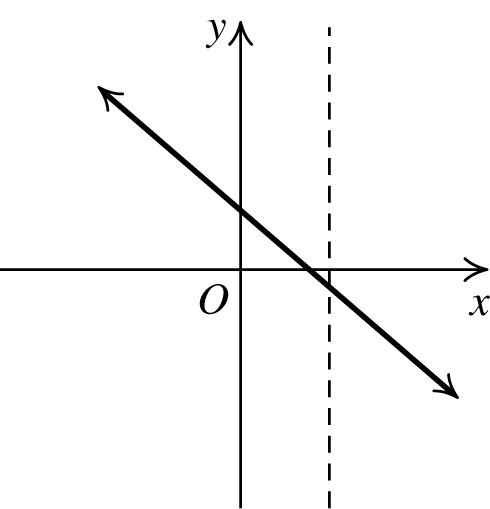
42. The denominator is not defined for x = –2 or x = 2. The domain is (,2)(2,2)(2,). −∞−−∞ ∪∪
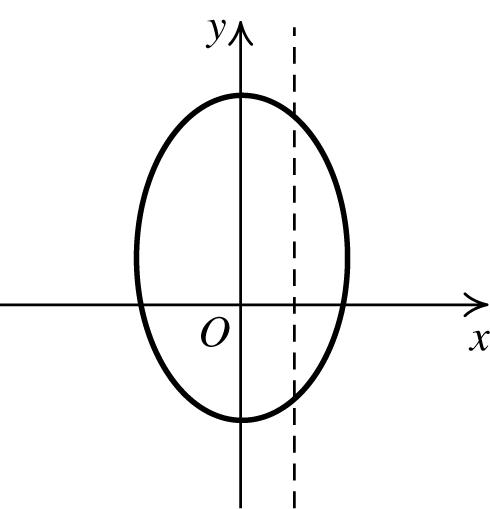

43. The numerator is not defined for x < 3, and the denominator is not defined for x = –2. The domain is [3,) ∞
44. The denominator is not defined for x ≥ 4. The domain is (,4) −∞
Copyright © 2015 Pearson Education Inc.
55. (4)2;(1)1;(3)5;(5)7 ffff −=−−===
56. (2)5;(1)4;(3)0;(4)5 gggg −==−==
57. (2)5;(1)4;(0)3;(1)4 hhhh −=−−===
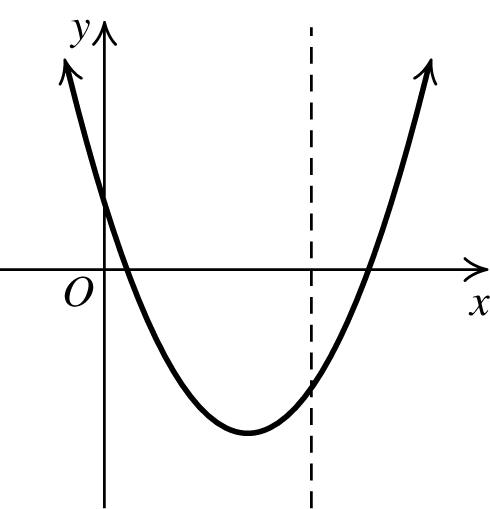

58. (1)4;(0)0;(1)4 fff−===−
59. ()7hx = , so solve the equation 2 71 xx =−+ .
2 60(3)(2)02xxxxx −−=⇒−+=⇒=− or 3. x =
60. ()7Hx = , so solve the equation 2 78 xx =++ .
2 114(1)(1) 10 2(1) xxx −±− ++=⇒=⇒
13 2 x −±− =⇒ there is no real solution.
61.a. 2 12(11)711, =−++⇒=− which is false. Therefore, (1, 1) does not lie on the graph of f
b. 22 2 12(1)72(1)6 (1)31313 xx xxx =−++⇒+=⇒ +=⇒+=±⇒=−±
The points ( )13,1 and ( )13,1−+ lie on the graph of f
c. () 2 20175yy =−++⇒=
The y-intercept is (0, 5).
14 1 2 x =−±
The x-intercepts are 14 1,0 2 ⎛⎞ ⎜⎟ ⎝⎠ and 14 1,0. 2 ⎛ ⎞ −+ ⎜ ⎟
62.a. ()() 2 10321221012, =−−−−⇒= which is false. Therefore, (−2, 10) does not lie on the graph of f.
b. ()12fx = , so solve the equation
2 31212 xx −−= .
xxxx xxx xx
22 22 3121244 440(2)0 202
−−=⇒+=−⇒ ++=⇒+=⇒ +=⇒=−
c. ()() 2 301200yy =−−⇒=
The y-intercept is (0, 0).
d. () 2 0312034 0 or 4 xxxx xx =−−⇒=−+⇒ ==−
The x-intercepts are (0, 0) and (−4, 0).
63. Domain: [−3, 2]; range: [−3, 3]
64. Domain: [−1, 3]; range: [−2, 4]
65. Domain: [ ) 4, −∞ ; range: [−2, 3]
66. Domain: ( ] ,4−∞ ; range: [−1, 3]
67. Domain: [ ) 3, −∞ ; range: [ ] { }1,43 ∪
68. Domain: ( ) [ ) ,11,4−∞− ∪
Range: (−2, 4]
69. Domain: ( ] [ ] [ ) ,42,24, −∞−∞ ∪∪
Range: [ ] { }2,23 ∪
70. Domain: ( ) [ ) ,21, −∞−−∞ ∪
Range: ( ) , −∞∞
71. [ ) 9, −∞ 72. [–1, 7]
73. –3, 4, 7, 9 74. 6
d. ()() ()
22 2
0217721 7714 11 222
=−++⇒−=−+⇒ =+⇒±=±=+⇒
xx xx
75. ( ) ( ) ( ) 74,15,52fff−===
76. ( ) ( ) ( ) 44,17,33fff−=−==
77. { } [ ) 3.75,2.25,312, −−∞ ∪
Copyright © 2015 Pearson Education Inc.
78. ∅
79. [ ) 9, −∞ 80. { } [ ] 42,6 ∪
81. ( ) ( ) ( ) 41,13,34ggg−=−==
82. ( ) ( ) 55268gg−−=−−=
83. [ )9,5 84. [ ) 5, ∞
85. A function because there is only one high temperature per day.
86. A function because there is only one cost of a first-class stamp on January 1 each year.
87. Not a function because there are several states that begin with N (i.e., New York, New Jersey, New Mexico, Nevada, North Carolina, North Dakota); there are also several states that begin with T and S.
88. Not a function because people with a different name may have the same birthday.
89. 2 ();(4)16;AxxA== A(4) represents the area of a tile with side 4.
90. ();(3)2733in.;VxxV== V(3) represents the volume of a cube with edge 3.
91. It is a function. 2 ()6;(3)54SxxS==
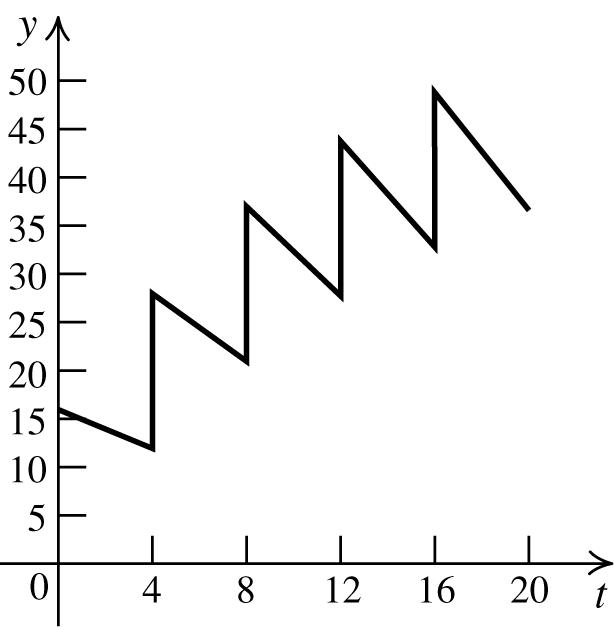

92. ();(59)1.5 39.37 x fxf=≈ meters
93.a. The domain is [0, 8].
b. 2 (2)128(2)16(2)192 h =−=
2 (4)128(4)16(4)256 h =−=
2 (6)128(6)16(6)192 h =−=
c. 2 012816016(8) tttt =−⇒=−⇒
0 or 8 tt== . It will take 8 seconds for the stone to hit the ground.
94. After 4 hours, there are (0.75)(16) = 12 ml of the drug.
After 8 hours, there are (0.75)(12 + 16) = 21 ml.
After 12 hours, there are (0.75)(21 + 16) = 27.75 ml.
After 16 hours, there are (0.75)(27.75 + 16) = 32.81 ml.
After 20 hours, there are (0.75)(32.81 + 16) = 36.61 ml.
95. () 2 2828 2828 xyyx Pxxxx +=⇒=− =−=−
96. ( ) () 2 6023030 3030 Pxyxyyx Axxxx ==+⇒=+⇒=−
97. Note that the length of the base = the width of the base = x

d.
98.
a. 222222 22 xyryrx yrx
+=⇒=−⇒ =−
The length of the rectangle is 2x and its height is 22 . yrx =−
=+=+−
() 22 22 22222 42 Plwxrx xrx
b. 22 2 Alwxrx ==−
Copyright © 2015 Pearson Education Inc.
99. The piece with length x is formed into a circle, so 2. 2 x Cxrr π π ==⇒= Thus, the area of the circle is 2 2 2 24 xx Arππ ππ ⎛⎞ === ⎜⎟
The piece with length 20 − x is formed into a square, so () 1 20420. 4 Pxssx =−=⇒=−
Thus, the area of the square is () () 2 2 2 11 2020. 416 sxx ⎡⎤ =−=−
The sum of the areas is () 2 2 1 20 416 x Ax π =+−
rrhrr ππππ π π
⎛ ⎞ +=+ ⎜ ⎟ ⎝ ⎠ =+
64 22 128 r r r
101. The volume of the pool is 2 2 288 288.Vxhh x ==⇒=
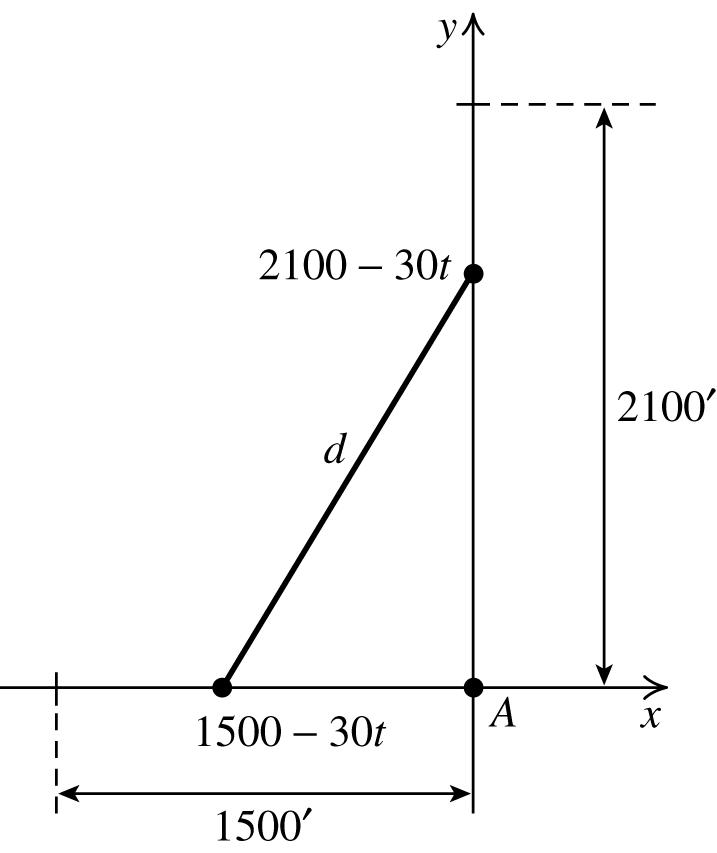
The total area to be tiled is 2 2881152 44xhx xx ⎛⎞ == ⎜⎟ ⎝⎠
The cost of the tile is 11526912 6. xx ⎛⎞ = ⎜⎟
⎝⎠
The area of the bottom of the pool is 2 , x so the cost of the cement is 2 2. x Therefore, the total cost is 2 6912 2.Cx x =+
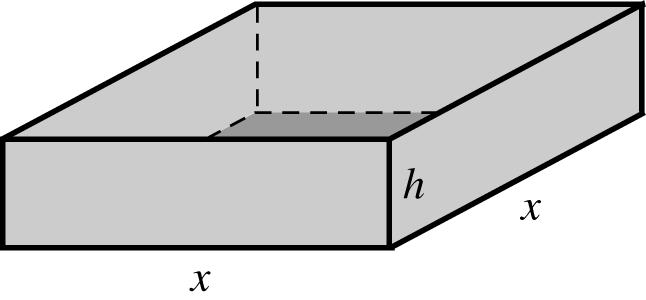
=−+−⇒
150030210030 150030210030
Using the distance formula we have ()() ()
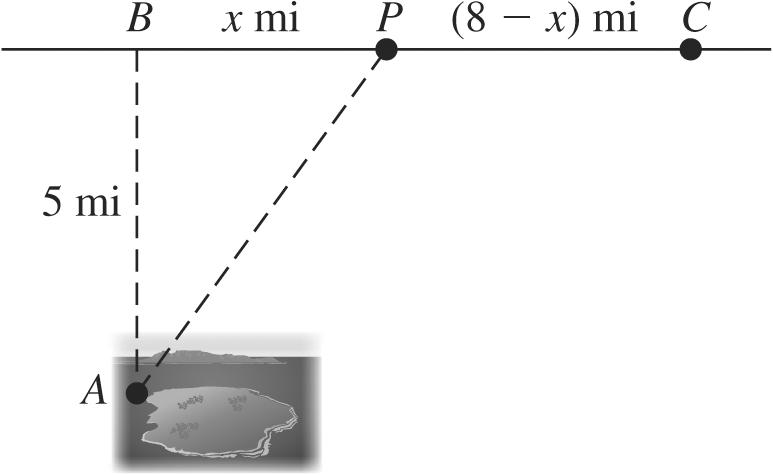
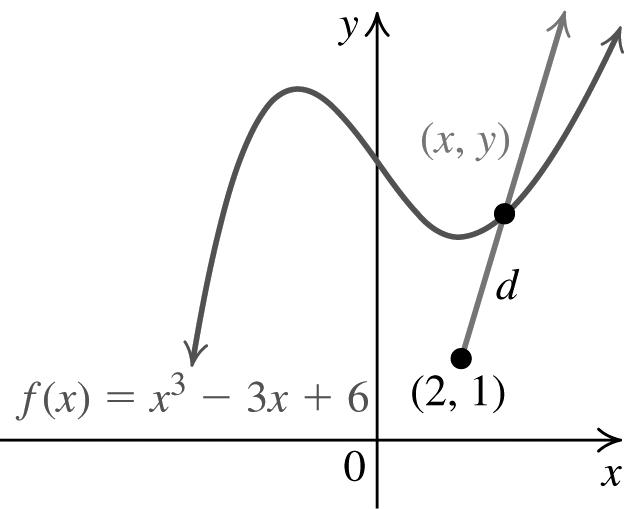
2 2 3 2 2 3 12 2 2 3 21 2361 235 235 dxy xxx xxx xxx =−+− ⎡ ⎤ =−+−+− ⎣ ⎦ =−+−+ ⎡⎤ =−+−+ ⎢⎥ ⎣⎦ 104.
() () () () ()
The distance from A to P is 222525xx+=+ mi. At 4 mi/hr, it will take Julio 2 25 4 x + hr to row that distance. The distance from P to C is (8 − x) mi, so it will take Julio 8 5 x hr to walk that distance. The total time it will take him to travel is 2 258 45 xx T +−
Copyright © 2015 Pearson Education Inc.